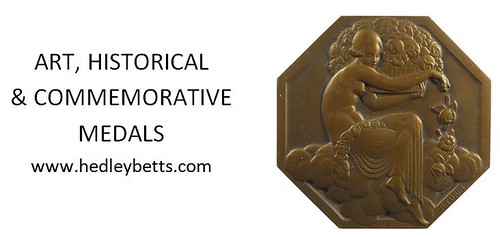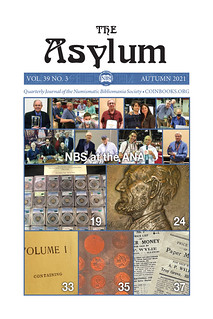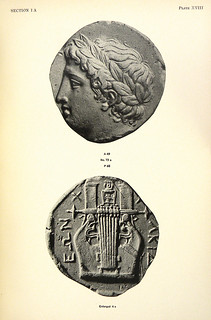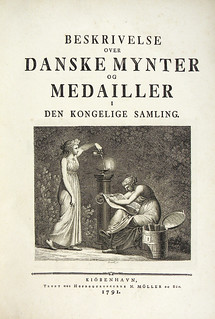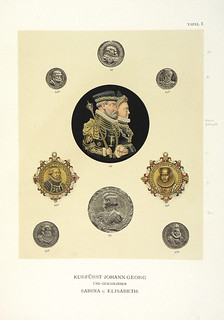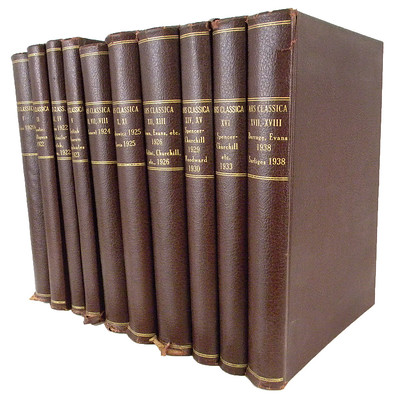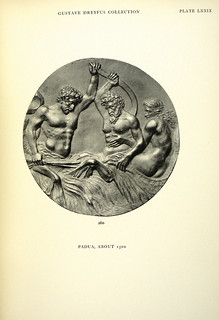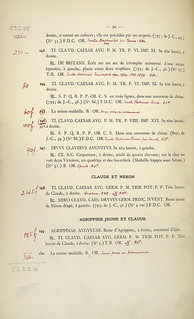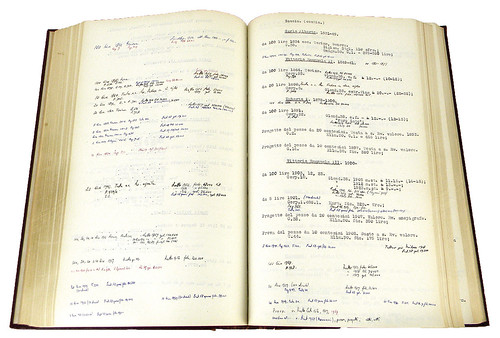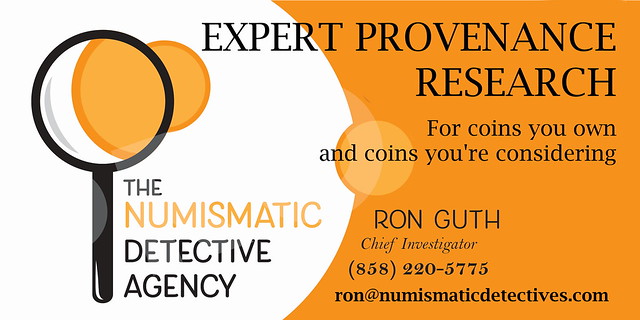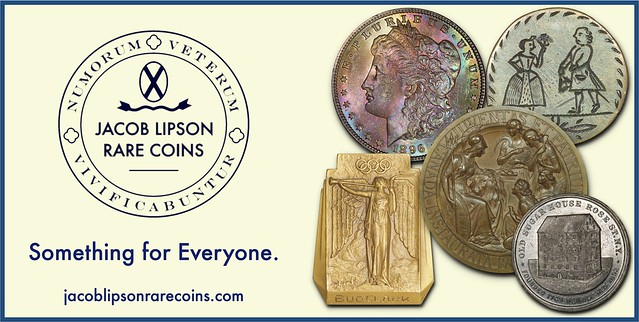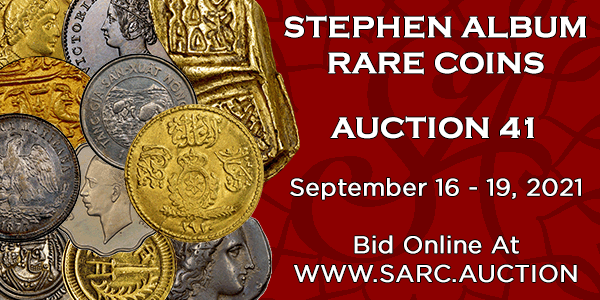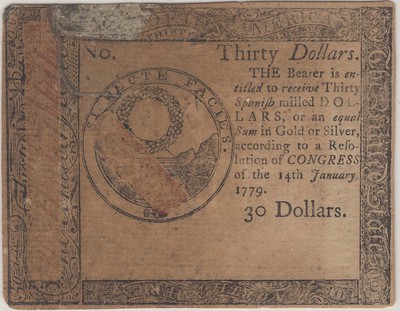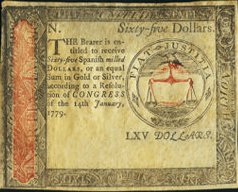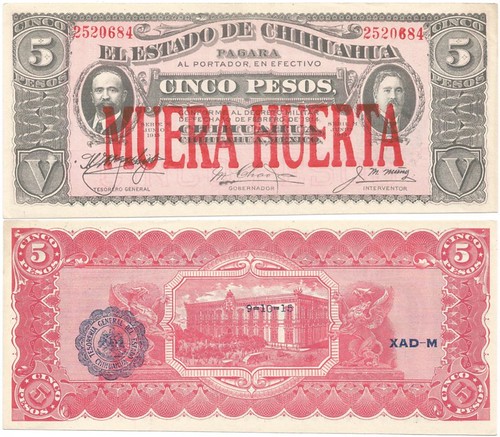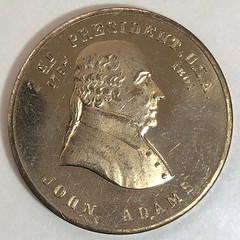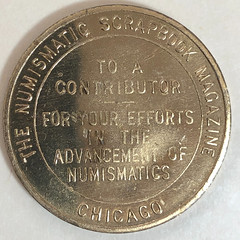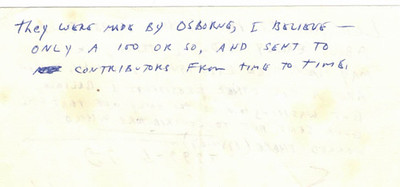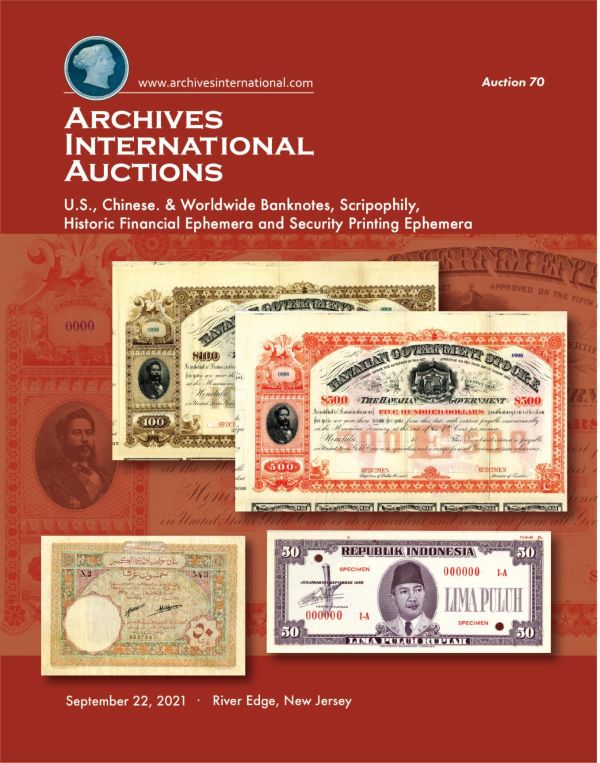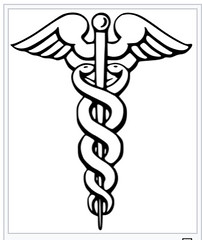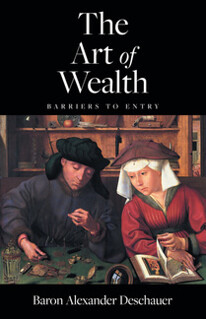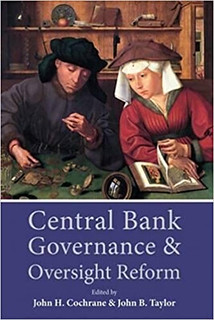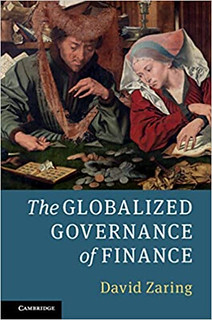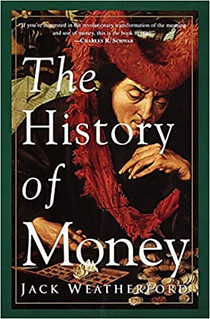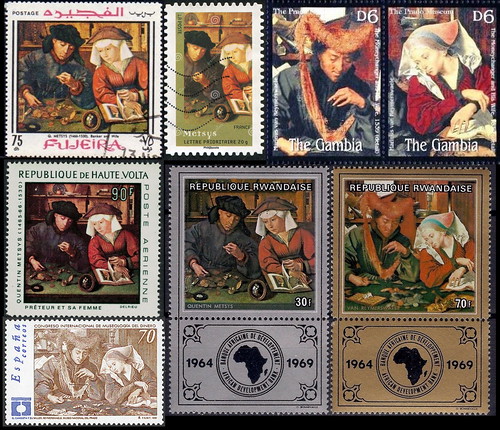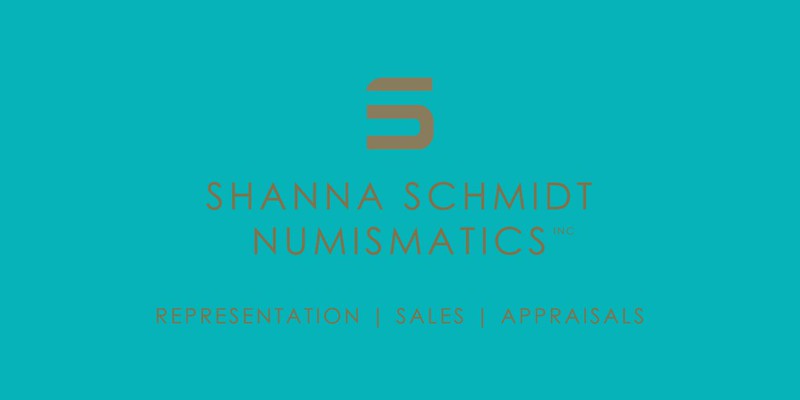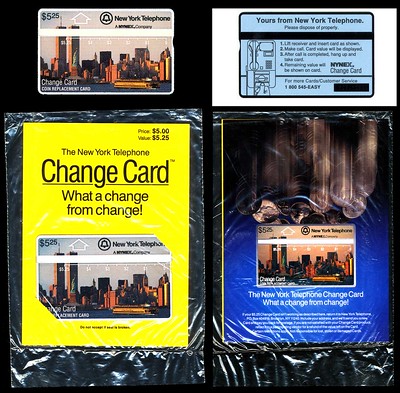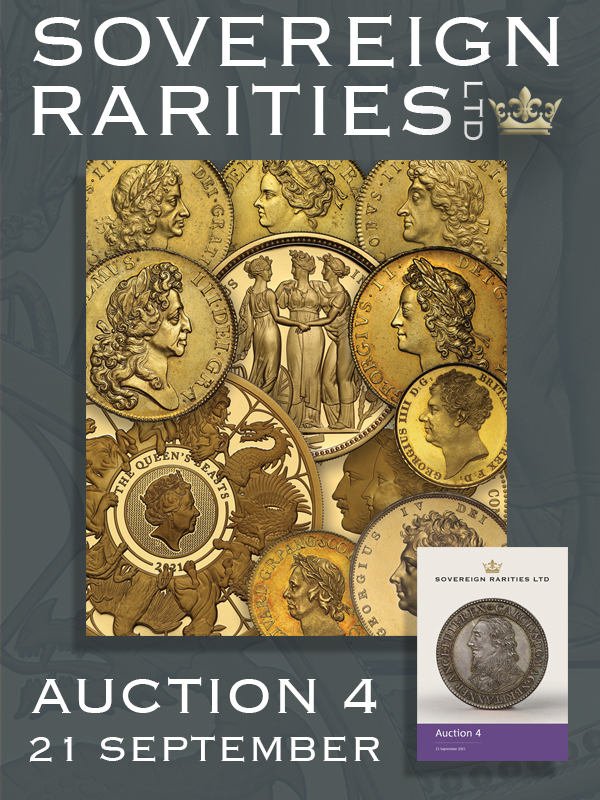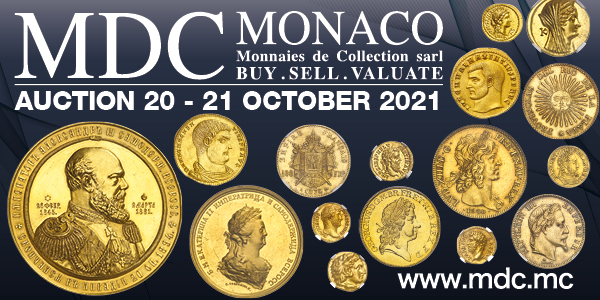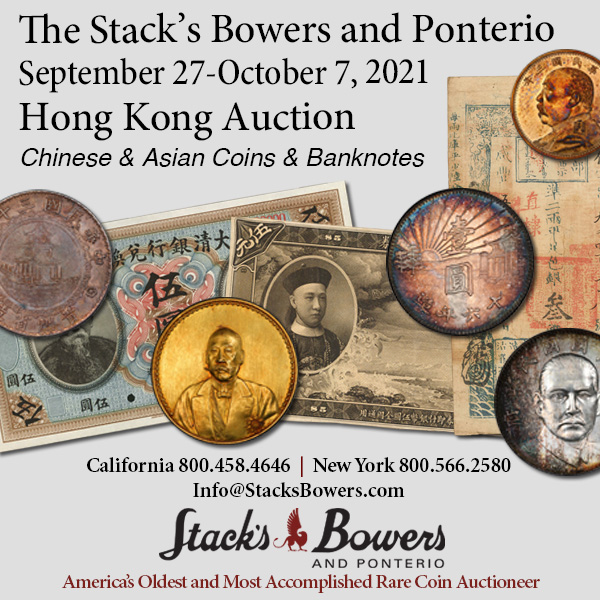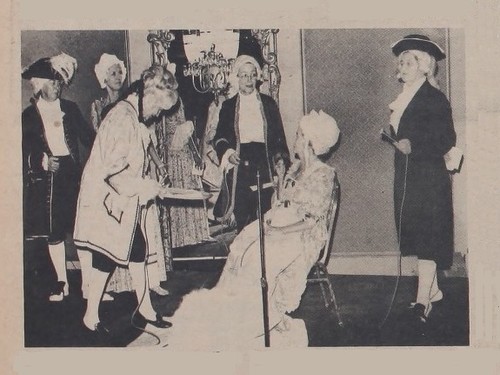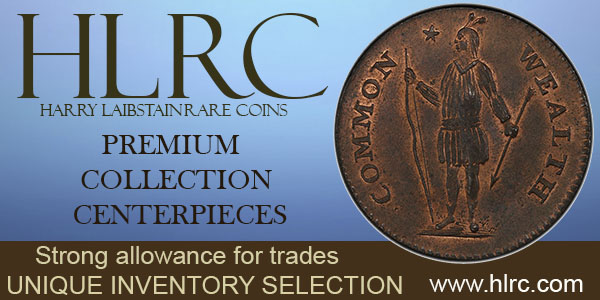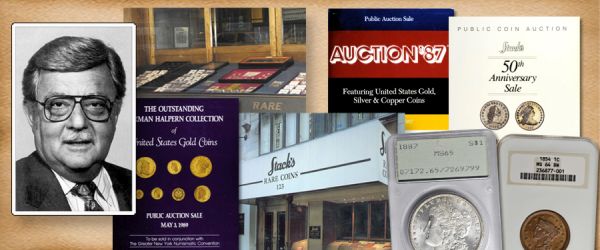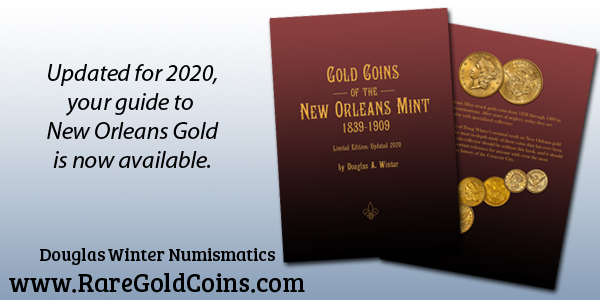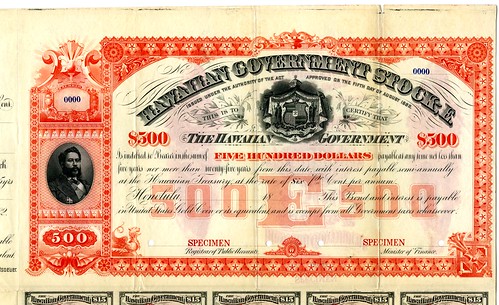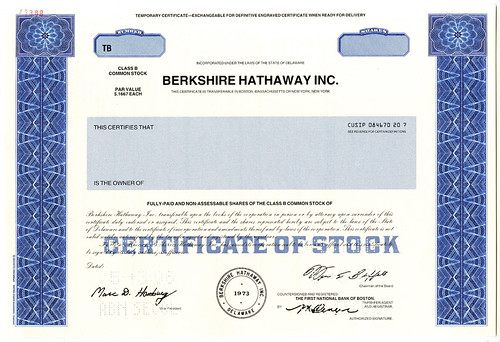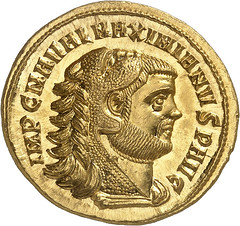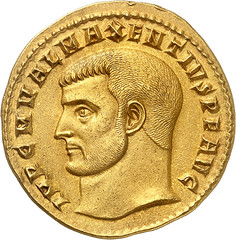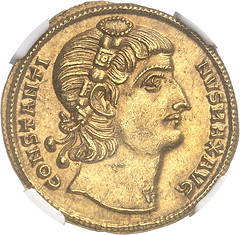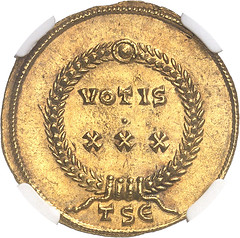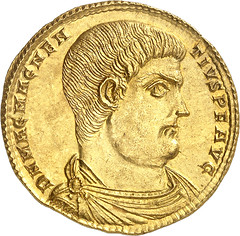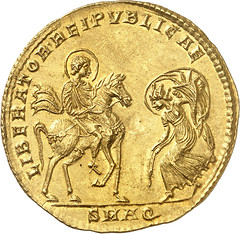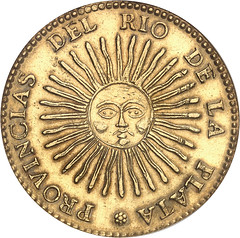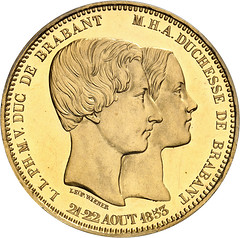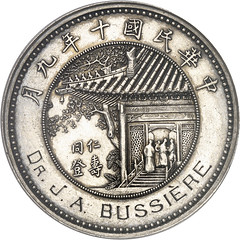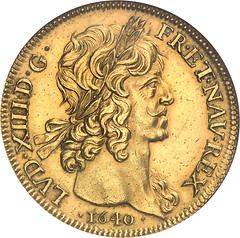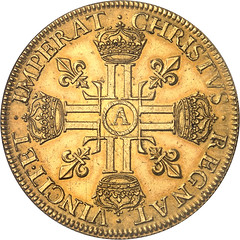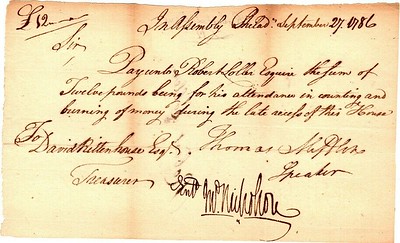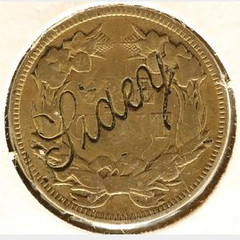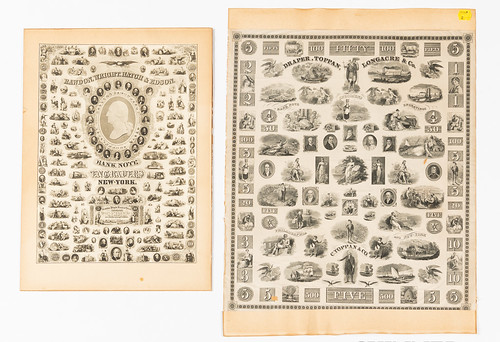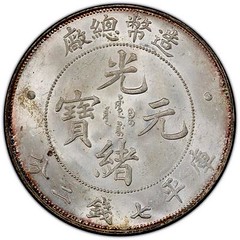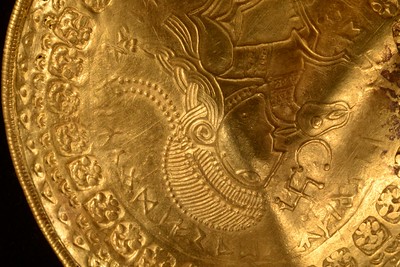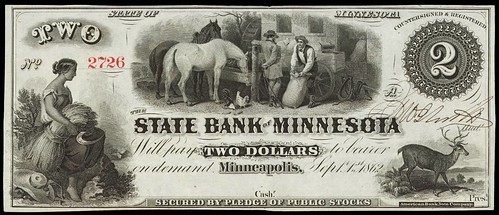
Visit our NBS Sponsors


About UsThe Numismatic Bibliomania Society is a non-profit association devoted to the study and enjoyment of numismatic literature. For more information please see our web site at coinbooks.org SubscriptionsThose wishing to become new E-Sylum subscribers (or wishing to Unsubscribe) can go to the following web page link MembershipThere is a membership application available on the web site Membership Application To join, print the application and return it with your check to the address printed on the application. Print/Digital membership is $40 to addresses in the U.S., and $60 elsewhere. A digital-only membership is available for $25. For those without web access, write to: Charles Heck, Treasurer AsylumFor Asylum mailing address changes and other membership questions, contact Chuck at this email address: treasurer@coinbooks.org SubmissionsTo submit items for publication in The E-Sylum, write to the Editor at this address: whomren@gmail.com BUY THE BOOK BEFORE THE COIN |
- WAYNE'S WORDS: THE E-SYLUM SEPTEMBER 12, 2021
- ASYLUM AUTUMN 2021 ISSUE PUBLISHED
- MORE KOLBE & FANNING SALTON SALE HIGHLIGHTS
- NEW BOOK: FEDERAL REPUBLIC COPPER
- NEW BOOK: ZACATECAS STATE COPPERS
- NEW BOOK: EMERGENCY NOTES OF THE DILLKREIS
- BOOK REVIEW: ALLIED MILITARY MARKS IN GERMANY
- MEGA RED ADDS CENTENNIAL SO-CALLED DOLLARS
- CHRISTIAN GOBRECHT ENGRAVING OF WASHINGTON
- VIDEO: 2021 TEXAS NUMISMATIC CONVENTION
- NEWMAN NUMISMATIC PORTAL THIRD SYMPOSIUM
- QUERY: CONTINENTAL CURRENCY REMAINDERS?
- MORE ON MUERA HUERTA OVERSTAMPS
- NUMISMATIC SCRAPBOOK CONTRIBUTOR TOKENS
- NOTES FROM E-SYLUM READERS: SEPTEMBER 12, 2021
- THOUGHTS ON THE ANNIVERSARY OF 9/11
- INDEXING VS. IMAGING THE NUMISMATIST
- VOCABULARY TERM: FINISH AND FINISHING, PART 2
- RITTENHOUSE HALF DISMES REENACTMENT
- HARVEY STACK'S NUMISMATIC FAMILY, PART 104
- CHRISTOPHER COMBER (1944-2019)
- URAM CONCLUDES TWO TERMS ON THE CCAC
- ARCHIVES INTERNATIONAL AUCTION 70
- MDC MONACO AUCTION 8
- MDC MONACO JEAN LECOMPTE COLONIAL TOKENS
- NUMISMATIC NUGGETS: SEPTEMBER 12, 2021
- DENMARK GOLD FIND EXHIBITED
- GOLD COIN CACHE FOUND IN FRENCH MANSION
- LOOSE CHANGE: SEPTEMBER 12, 2021
- FEATURED WEB SITE: MINNESOTA NICE
Click here to read the thin version on the web
Click here to subscribe
Click here to access the complete archive
To comment or submit articles, reply to whomren@gmail.com
Content presented in The E-Sylum is not necessarily researched or independently fact-checked, and views expressed do not necessarily represent those of the Numismatic Bibliomania Society.
WAYNE'S WORDS: THE E-SYLUM SEPTEMBER 12, 2021
 New subscribers this week include:
Jay Vavra, courtesy Dave Lange's
CoinWeek article;
Susan Bremer of Heritage,
and
NBS members
Tammen Beeman,
Christopher Bulfinch,
David Crenshaw,
John Davenport,
Paul Duffy,
Nicole Fry,
John Gatt,
Arthur Hickok,
Curtis Jacobs,
Ben Keele,
Jonathan Kern,
Donald Laux,
Lawrence Meiteles,
Rick Mullen,
Alan Newman,
Charles Sullivan,
Douglas Ward and
Jonathan Woensdregt;
New subscribers this week include:
Jay Vavra, courtesy Dave Lange's
CoinWeek article;
Susan Bremer of Heritage,
and
NBS members
Tammen Beeman,
Christopher Bulfinch,
David Crenshaw,
John Davenport,
Paul Duffy,
Nicole Fry,
John Gatt,
Arthur Hickok,
Curtis Jacobs,
Ben Keele,
Jonathan Kern,
Donald Laux,
Lawrence Meiteles,
Rick Mullen,
Alan Newman,
Charles Sullivan,
Douglas Ward and
Jonathan Woensdregt;
Welcome aboard! We now have 6,701 subscribers.
Thank you for reading The E-Sylum. If you enjoy it, please send me the email addresses of friends you think may enjoy it as well and I'll send them a subscription. Contact me at whomren@gmail.com anytime regarding your subscription, or questions, comments or suggestions about our content.
This week we open with a new issue of our print journal, highlights from the Salton library sale, three new books and a review, updates from the Newman Numismatic Portal, and more.
Other topics this week include Centennial So-Called Dollars, Continental Currency, Numismatic Scrapbook Magazine, Christopher Comber, Tom Uram, auction previews, gold coin finds, and Minnesota banknotes.
To learn more about Ars Classica, Mexican numismatics, Allied Military Currency marks, Christian Gobrecht's engraving of Washington, the NNP Symposium, multi-generation numismatic families,
Hawaiian Government Stock
Bonds, French colonial numismatics
and the Rod of Asclepius, read on. Have a great week, everyone!
Wayne Homren
Editor, The E-Sylum
ASYLUM AUTUMN 2021 ISSUE PUBLISHED
The 2021 Autumn issue of The Asylum is on the way from our sponsor, the Numismatic Bibliomania Society. Maria Fanning edits our print journal, and she submitted this report and President Tom Harrison's message. -Editor
The Asylum Autumn 2021
The Asylum's Autumn 2021 issue will be mailing to NBS members soon. We had a great time seeing everyone at the ANA in Rosemont and hope to see those who could not attend next year.
Congratulations to Wayne Homren and The E-Sylum for winning First Place for the ANA's Outstanding Electronic Numismatic Publication!
- NBS at the ANA World’s Fair of Money including NBS Symposium and General Meeting Reports by Joel J. Orosz, Benefit Auction Results by Tom Harrison, Treasurer’s Report by Chuck Heck and an NBS at the World’s Fair of Money photo journal
- Happenings at Table 611 at the 2021 ANA World’s Fair of Money by W. David Perkins, NLG
- BiblioFiles profiles: Cole Hendrickson and David Pickup
-
ASSOCIATIONS: Autographs • Annotations • Inscriptions
The Brooks Family Copy of the Lincoln Centennial Medal and Me: Brought Together by
A Simple Twist of Fate
by Joel J. Orosz - John J. Ford, Jr., and a Bibliophilic Deception by David D. Gladfelter
- Catalogue Printing Plate Mystery by Dr. Larry Meiteles
- The Story of Alexander P. Wylie by William A. Burd
Message from the NBS President, Tom Harrison
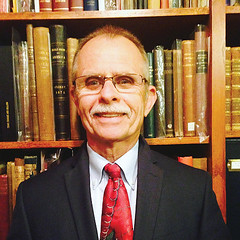 Although we missed many of our friends at this year’s NBS events at the ANA World’s Fair of Money, those who were in attendance demonstrated plenty of enthusiasm for numismatic literature. The NBS hosted our club table from Tuesday to Friday. Thank you to everyone who stopped by to share their passion for numismatic literature, view items for Friday’s charitable auction and to receive an NBS commemorative coffee mug for a $25 donation.
Although we missed many of our friends at this year’s NBS events at the ANA World’s Fair of Money, those who were in attendance demonstrated plenty of enthusiasm for numismatic literature. The NBS hosted our club table from Tuesday to Friday. Thank you to everyone who stopped by to share their passion for numismatic literature, view items for Friday’s charitable auction and to receive an NBS commemorative coffee mug for a $25 donation.
The Symposium featured Rusty Goe, an authority on the Carson City Mint and its coinage. His presentation included a survey of literature related to the Carson City Mint, fascinating stories of Mint-related personalities and a number of the coins produced on Carson Street. Following his previous two award-winning books detailing the Carson City Mint, his research has culminated with his recent three-volume definitive work entitled The Confident Carson City Coin Collector, which received the Numismatic Literary Guild Book of the Year Award. On behalf of the NBS membership, thank you, Rusty!
The 42nd annual General Meeting was highlighted by The Asylum author awards, our all-important charity auction and a presentation by NBS Vice President Len Augsburger, discussing the digitalization of Coin World and Numismatic News. It was announced that The E-Sylum received first place in the electronic category of the ANA’s Barbara J. Gregory Outstanding Club Publication Competition. Also, David and Maria Fanning of Kolbe & Fanning Numismatic Booksellers received first place in the Numismatic Literary Guild Best Auction Catalog category for their Richard Margolis International Numismatic Library Sale. Congratulations to David, Maria, and to Wayne and everyone who contributed to the continued success of The E-Sylum for these well-deserved awards.
Again this year, our most generous membership stepped up in a big way to provide programming opportunities and to ensure the financial health of the NBS. Thanks to our openhanded donors and bidders, to David and Maria Fanning for cataloging the sale and to David for serving as our auctioneer, the NBS raised $9150! Thanks to the efforts of many devoted numismatists, the entire convention was a resounding success.
Please be sure to read Joel Orosz’s detailed reports about the Symposium and General Meeting. May your library provide investigation, discovery and most of all, enjoyment.
Remember, while The E-Sylum is free to all, only paid members of the Numismatic Bibliomania Society receive our print journal, The Asylum. Print/Digital membership is $40 to addresses in the U.S., and $60 elsewhere. A digital-only membership is available for $25. -Editor
To join NBS or renew your membership, see:
https://www.coinbooks.org/about/membership.html
MORE KOLBE & FANNING SALTON SALE HIGHLIGHTS
Here are some more highlights from the upcoming Kolbe & Fanning sale of the Salton library. -Editor
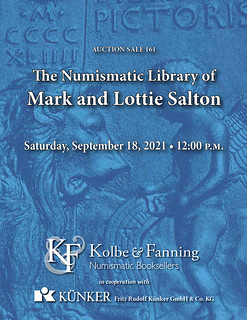 Kolbe & Fanning Numismatic Booksellers are selling at auction the Mark and Lottie Salton numismatic library on Saturday, September 18. The sale includes important publications on ancient, medieval and modern coins from around the world, as well as outstanding works on medals and an extraordinary collection of European auction catalogues. The sale is being held in cooperation with Fritz Rudolf Künker, of Osnabrück, Germany.
Kolbe & Fanning Numismatic Booksellers are selling at auction the Mark and Lottie Salton numismatic library on Saturday, September 18. The sale includes important publications on ancient, medieval and modern coins from around the world, as well as outstanding works on medals and an extraordinary collection of European auction catalogues. The sale is being held in cooperation with Fritz Rudolf Künker, of Osnabrück, Germany.
Some highlights of the sale include:
Lot 11: Erich Boehringer’s rare and desirable Die Münzen von Syrakus, an enormously important work on Syracusan coins
Lot 54: Ernst Justus Haeberlin’s magnificent 1910 Aes Grave, including its massive plate volume with 103 exceptionally fine plates
Lot 106: Robinson & Clement’s rarely encountered study on the Chalcidic Mint
Lot 132: the 1553 first edition of Aenea Vico’s heavily illustrated compendium on Roman coins, Omnium Caesarum verissimae imagines ex antiquis numismatis desumptae
Lot 171: the superb 1791 Beskrivelse over danske mynter og medailler in den kongelige samling, the foundational classic on Danish coins
Lot 194: Julius Menadier’s extraordinary 1901 folio on the Schaumünzen des Hauses Hohenzollern
Lot 284: a complete set of the Ars Classica auction catalogues of ancient coins, published between 1921 and 1938 by Jacob Hirsch
Lot 237: an original copy of Seymour de Ricci’s enormous catalogue of the Gustave Dreyfus collection of Italian reliefs and plaquettes; lot 245 features G.F. Hill’s complementary volume on the Dreyfus collection of Renaissance medals
Lot 400: an annotated copy of the 1896 Rollin & Feuardent catalogue of the Montagu collection of Roman & Byzantine gold coins, with 41 splendid plates
Lot 457: Felix Schlessinger’s bound volumes of coin auction records, continued by his son, Mark Salton, and consisting of 2892 typewritten leaves further annotated in ink, recording tens of thousands of sale records.
Register early to bid online
To register for the online sale, go to
bid.numislit.com and sign up. You may then browse lots, place advance bids, or participate in the live sale online. Those wishing to participate on their devices can download the Kolbe & Fanning app through the Apple or Google Play Store. The printed catalogue of the Salton Library has been mailed to all active customers on our mailing list, and traditional absentee bids may be placed via post, email, fax or phone. The sale is also available through Biddr, Sixbid and NumisBids.
Please note that bids placed via post, email, fax or phone must be received by September 17, the day before the sale, in order for them to be processed. Advance absentee bids may also be placed at any time online at bid.numislit.com. Live internet bidding will be available during the sale itself through the same platform.
Kolbe & Fanning Numismatic Booksellers LLC is a licensed and bonded auction firm in the State of Ohio. For more information, please see the Kolbe & Fanning website at numislit.com or email David Fanning at df@numislit.com. To register for the sale, go to bid.numislit.com. We look forward to your participation.
To read the earlier E-Sylum articles, see:
KOLBE & FANNING SALTON LIBRARY SALE
(https://www.coinbooks.org/v24/esylum_v24n35a02.html)
KOLBE & FANNING SALTON SALE HIGHLIGHTS
(https://www.coinbooks.org/v24/esylum_v24n36a02.html)
NEW BOOK: FEDERAL REPUBLIC COPPER
David Lisot alerted me to a couple of recent books on Mexican numismatics that we haven't discussed yet. Look for his video next week from the recent Texas Numismatic Association Convention. I reached out to author Greg Meyer and he kindly provided this information. Thanks. -Editor
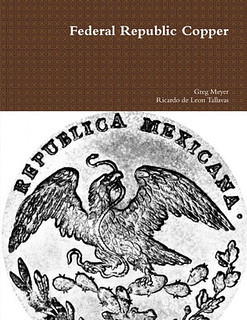 Federal Republic Copper was written with Ricardo de Leon Tallavas and relates how the history behind the copper coinage of the Mexico City mint in the colonial period informs the first republic Mexico City copper coinage of 1829-1862. It has high resolution black and white photos of die varieties of each year and denomination.
Federal Republic Copper was written with Ricardo de Leon Tallavas and relates how the history behind the copper coinage of the Mexico City mint in the colonial period informs the first republic Mexico City copper coinage of 1829-1862. It has high resolution black and white photos of die varieties of each year and denomination.
This book discusses the New Spain and first Mexican Republic fiat currencies of copper. Specific focus of coin analysis is of the Federal issues from 1829-1861. Varieties are pictured and discussed in detail.
Authors: Greg Meyer and Ricardo de Leon Tallavas
Publication Date: Jan 9, 2017
Language: English
Pages: 120
Binding: Paperback
Interior Color: Black & White
Dimensions: US Letter (8.5 x 11 in / 216 x 279 mm)
Price: USD 30.00
For more information, or to order, see:
Federal Republic Copper
(https://www.lulu.com/en/us/shop/ricardo-de-leon-tallavas-and-greg-meyer/federal-republic-copper/paperback/product-1djepkw5.html)
NEW BOOK: ZACATECAS STATE COPPERS
Here's the second recent book on Mexican numismatics by Greg Meyer. -Editor
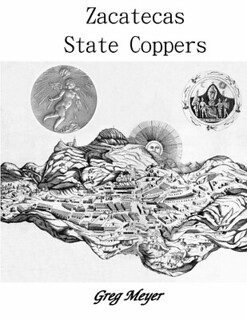 Zacatecas State Coppers focuses strictly on the history of the Mexican state of Zacatecas in the first republic period 1824-1863 and events that led to reduced mintages or no mintage at all of copper coinage. It also has high resolution black and white photos of die varieties of each year and denomination.
Zacatecas State Coppers focuses strictly on the history of the Mexican state of Zacatecas in the first republic period 1824-1863 and events that led to reduced mintages or no mintage at all of copper coinage. It also has high resolution black and white photos of die varieties of each year and denomination.
A numismatic study and history of the Zacatecas state copper production from 1825 to 1863. Commonly known as 'Angels' or 'Angelitos' the quartillas and octavos of this coin series were essential to every day commerce and due to the finely detailed symbology on both sides of the coin, very hard to counterfeit with the common technology at the time.
Author: Greg Meyer
Publication Date: Jan 28, 2020
Language: English
Pages: 116
Binding: Paperback
Interior Color: Black & White
Dimensions: US Letter (8.5 x 11 in / 216 x 279 mm)
Price: USD 30.00
For more information, or to order, see:
Zacatecas State Coppers
(https://www.lulu.com/en/us/shop/greg-meyer/zacatecas-state-coppers/paperback/product-1e4dnqj7.html)
NEW BOOK: EMERGENCY NOTES OF THE DILLKREIS
An article by Uwe Bronnert on Geldscheine Online discusses a new book by Eckehard Gottwald on the emergency banknotes of the Dillkreis, a rural district west of Hesse, Germany. Below is a Google-translated excerpt. -Editor
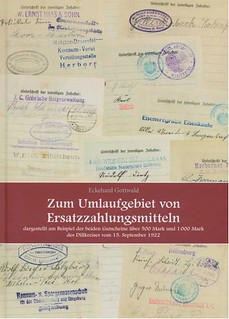 Eckehard Gottwald:
Eckehard Gottwald:
On the circulation area for replacement means of payment
A contribution to the history of the former Dillkreis. 2nd Edition,
Hofheim am Taunus 2021. 94 pages, full color illustrations, adhesive binding and cardboard cover, without ISBN.
Available from the author at a price of € 29.00 + € 4.00 postage and packaging, Brückenstraße 45, 65719 Hofheim a. T.
24 years have passed since the first edition of this study. Now the author, who is known for his books on the Frankfurt, Offenbach and Hanau emergency money, presents the collector community with a revised presentation of the topic, which at first glance is quite limited. When leafing through the book for the first time, it becomes clear that the author has a lot to say about the 500- and 1000-mark notes of the Dillkreis.
Many treatises on numismatics of antiquity, the Middle Ages and the early modern period deal with the question of the circulation area of certain coins. With paper money and especially with emergency money, this topic is only dealt with marginally, if at all, although the emergency money was often found far outside the actual issuing area. This is proven in many cases by contemporary reports and newspaper reports. Letters that have been preserved with redemption requests from foreign emergency money holders also provide evidence of the area of ??distribution. However, all of these references are only snapshots.
Gottwald therefore chose a different approach in his study. The emergency banknotes of the Dillkreis for 500 and 1000 marks from September 15, 1922 even provide information about where they were used, because they should be endorsed by every holder on the back before passing them on. An evaluation of these endorsements would therefore have to give a precise picture of their area of ??distribution. However, the relative rarity of these notes stood in the way of this. While Gottwald was only able to evaluate 173 notes (97 of the 500 and 76 of the 1000) in the first edition, there are now 355 vouchers for 500 marks out of a probably originally 68,854 copies and 226 vouchers for 1,000 marks out of the original 25,865 pieces. 3947 signatures and company stamps were found on the 581 notes evaluated.
Almost half of the 2264 endorsements for the 500-mark voucher came from the Dill district itself, almost 17% from the Oberwesterwaldkreis, and 7% from other districts, including those far away, such as Kassel, Wiesbaden, Siegburg and Limburg.
The actual investigation is preceded by a history of the Dillenburg emergency money, which also does not spare the company emergency money. In this context, the rare 1000 Mark note issued by the Hessen-Nassau Hüttenverein in Steinbrücken should be emphasized.
The detailed information is based on the archives of the Hessian main state archive in Wiesbaden and historical editions of the Dill newspaper from the Dillenburg city archive.
During his research, Gottwald also solved a little secret. To prevent counterfeiting and to identify the real 500-mark bills, the printer attached a secret sign that was made by imperceptibly destroying it at any point on the frame. He found the same error
in all 355 notes that he examined: In the frame of the obverse, a point is missing on the left of the fourth rosette from the bottom. So far, four variants of the 1000 Mark voucher were known, which result from the different positions of the decorative pieces on the edge strips. When looking through the notes, Gottwald found two other variants.
If the first edition consisted of copied sheets in a clip-on folder, the new edition comes as a cheaply bound book in A4 format. The emergency money bills are shown in color, notifications of emergency money issues and official price lists complete the explanations. In addition, many endorsers are introduced through the rendering of contemporary newspaper advertisements.
The book is not only important for home collectors, it is also an enrichment for any numismatic library.
A number of U.S. Depression Scrip notes have the same feature, where some record is made of each transaction using the note. This allows for interesting studies of circulation and the local economy at the time. -Editor
To read the complete article, see:
Eckehard Gottwald: Zum Umlaufgebiet von Ersatzzahlungsmitteln
(https://www.geldscheine-online.com/post/eckehard-gottwald-zum-umlaufgebiet-von-ersatzzahlungsmitteln)
BOOK REVIEW: ALLIED MILITARY MARKS IN GERMANY
Steve Feller published the following review in the 11 September 2021 issue of MPC Gram, the newsletter for collectors of Military Payment Certificates and other military numismatica. -Editor
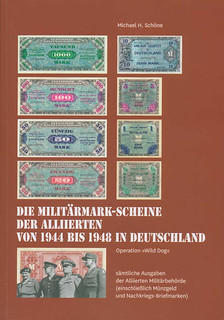 The following announcement by Hans-Ludwig Grabowski appeared in the E-Sylum a few weeks ago.
The following announcement by Hans-Ludwig Grabowski appeared in the E-Sylum a few weeks ago.
First, however, I present a few comments. My copy just arrived after purchase from Michael. It is a superlative book. It is a catalog and ever so much more.
In fact, the catalog part is a tiny aspect of the book. It is filled with contemporary references to the money that fills in many details about the issuance of AMC marks in Germany. It is filled with a tremendous amount of original data on the money.
Indeed, this book revolutionizes our knowledge of this currency–a currency a lot of us take for granted.
Now the book is written in German. This will require some patience to use as a result. Interestingly a lot of the original documents are in English as they were written by and for the use of the occupying powers.
There is much intrigue here too about the Soviet issues—you will learn much.
My advice is:
1. Read the notice below.
2. Send Michael H. Schöne, michael@schoene-pirna.de an email and arrange to pay him 45 euros plus postage by Paypal or otherwise. He will tell you how much by return email. 3. Enjoy and use the book.
To read the earlier E-Sylum article, see:
NEW BOOK: ALLIED MILITARY MARKS IN GERMANY
(https://www.coinbooks.org/v24/esylum_v24n31a06.html)
MEGA RED ADDS CENTENNIAL SO-CALLED DOLLARS
This press release notes a new addition to the Mega Red Book. -Editor
1876 CENTENNIAL EXPOSITION SO-CALLED DOLLARS IN THE MEGA RED BOOK
The Deluxe Edition of The Guide Book of U.S. Coins will showcase So-Called Dollars
This is exciting news not only for so-called dollar collectors, but for the entire hobby as well because this will give exposure and educate collectors on a historically significant and diverse segment of our hobby.
So-called dollars from the 1876 U.S. Centennial Exposition are being showcased in the latest Mega Red Book, the seventh deluxe edition of A Guide Book of United States Coins, published by Whitman Publishing. Over 80 medals and 300 varieties are depicted, along with photos, values and rarity information, many of which have never been cataloged before. Contributing author Jeff Shevlin, an expert on so-called dollars, has incorporated a different section on so-called dollars into each edition of the Mega Red since its inception seven years ago.
So-called dollars are U.S. medals about the size of a silver dollar struck to commemorate events in the United States history. More than 750 varieties are known, half of which are associated with a fair or exposition; the others commemorate important events in American history.
Whitman publisher Dennis Tucker says, The Centennial Exposition of 1876 was a grand affair, attended by 10 million visitors to celebrate the 100th anniversary of American independence. In the seventh edition of Mega Red, Jeff Shevlin lays out a colorfully illustrated catalog of more than 300 varieties of So-Called Dollars - historic medals designed and engraved by well-known artists like William Barber, George B. Soley, William Key, George H. Lovett, Abraham Demarest, Carl Stubenrauch, and Rudolf Laubenheimer. In 2026 America will have a suite of new coins in our pocket change to commemorate 250 years of independence. In the meantime we can look back to our 100th anniversary and enjoy these beautiful, historic, and collectible So-Called Dollars of America’s centennial.
To give readers a sense of the so-called dollars' vast history, here is an example highlighted in the Mega Red Book.
1876 Centennial Exposition Official So-Called Dollar
 This medal was designed and engraved by Charles Barber, the chief engraver of the U.S. Mint. The allegorical symbolism depicted on this 38mm U.S. Mint medal tells an interesting story about the United States. At the time of the 1876 Centennial Exposition in Philadelphia, most of Europe considered the United States to be a third-world country. The obverse depicts Liberty, representing the United States, rising up with her left hand reaching for the stars and greatness. The message was that the United States would rise in importance and be recognized as a world power. Historically, heraldry is depicted using an olive branch in the figure’s right hand and a sword in the left (meaning peace is preferred but action will be taken if necessary). In the case of the 1876 Centennial Exposition medal, the sword is in Liberty’s right hand, signifying that the United States is not to be trifled with.
This medal was designed and engraved by Charles Barber, the chief engraver of the U.S. Mint. The allegorical symbolism depicted on this 38mm U.S. Mint medal tells an interesting story about the United States. At the time of the 1876 Centennial Exposition in Philadelphia, most of Europe considered the United States to be a third-world country. The obverse depicts Liberty, representing the United States, rising up with her left hand reaching for the stars and greatness. The message was that the United States would rise in importance and be recognized as a world power. Historically, heraldry is depicted using an olive branch in the figure’s right hand and a sword in the left (meaning peace is preferred but action will be taken if necessary). In the case of the 1876 Centennial Exposition medal, the sword is in Liberty’s right hand, signifying that the United States is not to be trifled with.
In addition to the photos of the obverse and reverse, a spreadsheet of values, compositions and rarity information is cataloged with each example.
As Kenneth Bressett, editor emeritus of The Guide Book of United States Coins said, It is always refreshing to observe the enthusiasm shown by medal collectors for their favorite segment of numismatics. They view the artistry, history and significance of each piece as its prime importance in a way that is too often overlooked by those who simply collect coins with the objective of completeness or concern for condition.
For more information on these and other so-called dollars visit the so-called dollar collector’s website www.So-CalledDollar.com.
CHRISTIAN GOBRECHT ENGRAVING OF WASHINGTON
Newman Numismatic Portal Project Coordinator Len Augsburger provided the following discussion relating to work of early U.S. Mint engraver Christian Gobrecht. Thanks. -Editor
Christian Gobrecht Engraving of Washington from the ANA Convention
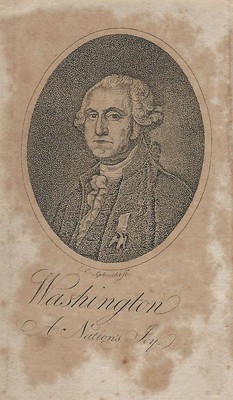 Christian Gobrecht (1785-1844), U.S. Mint Engraver from 1840-1844, worked in a variety of media, as did many of the early Mint engravers. Gobrecht, for example, created three different copperplate engravings of George Washington, one print of which appeared in the Liberty Seated Collectors Club (LSCC) fundraiser auction held during their annual meeting at the recent ANA convention. This version of Washington appeared in J. Kingston’s New American Biographical Dictionary (Baltimore, 1810). This author previously catalogued the copperplate engravings of Christian Gobrecht in Gobrecht Journal #101 (March 2008), available on Newman Portal.
Christian Gobrecht (1785-1844), U.S. Mint Engraver from 1840-1844, worked in a variety of media, as did many of the early Mint engravers. Gobrecht, for example, created three different copperplate engravings of George Washington, one print of which appeared in the Liberty Seated Collectors Club (LSCC) fundraiser auction held during their annual meeting at the recent ANA convention. This version of Washington appeared in J. Kingston’s New American Biographical Dictionary (Baltimore, 1810). This author previously catalogued the copperplate engravings of Christian Gobrecht in Gobrecht Journal #101 (March 2008), available on Newman Portal.
Only one other copy of this engraving has been located and resides in the Enoch Pratt Free Library in Baltimore. The present example is slightly different, with the text beneath the portrait off center. Apparently this text block was loosely attached to the printing plate and shifted in position. The Pratt Library example is correctly aligned. This print sold for $400.25, an odd amount ensured only by the ever-enthusiastic auctioneer Brad Karoleff. Having received a bid of $400, Mr. Karoleff then asked the same bidder for $425. Four hundred dollars and twenty-five cents
was offered, and, there being no further bids, completed the competition.
Link to Gobrecht catalog in The Gobrecht Journal, #101:
https://nnp.wustl.edu/library/book/176
VIDEO: 2021 TEXAS NUMISMATIC CONVENTION
These are selections from the David Lisot Video Library that feature news and personalities from the world of coin collecting. David has been attending coin conventions since 1972 and began videotaping in 1985. The Newman Numismatic Portal now lists all David’s videos on their website at:
https://nnp.wustl.edu/library/multimediadetail/522852
Here's one on the recent Texas Numismatic Association Convention. -Editor
Coin Buyers Abundant at Texas Numismatic Association Convention 2021
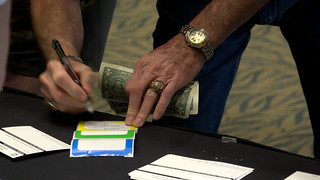 June 5, 2021. Doug Davis, Show Producer, Texas Numismatic Association, David Lisot, Interviewer, CoinTelevision.com.
June 5, 2021. Doug Davis, Show Producer, Texas Numismatic Association, David Lisot, Interviewer, CoinTelevision.com.
One of the first major national coin conventions to take place was the TNA Convention in Arlington, Texas June 3-6, 2021. Doug Davis, Show Producer, talks about attendance, the buyers and the sellers at the convention.
An excerpt of the video is available for viewing on the Coin Television YouTube Channel at:
https://youtu.be/neWCFYPdv6s
NEWMAN NUMISMATIC PORTAL THIRD SYMPOSIUM
Another NNP Symposium is on the way! Here's the announcement. -Editor
October 15-17, 2021
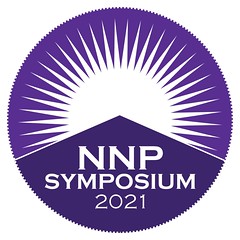 Launched in August 2020, the Newman Numismatic Portal (NNP) Symposium
brings together a diverse selection of numismatic presentations into a concentrated, three-day, Zoom-based format. Previous Symposia featured talks on a variety of topics including U.S. federal coinage, tokens and medals, paper money, and ancient and world numismatics. The complete set of over seventy presentations from the August 2020 and March 2021 events, produced by Lianna Spurrier of Numismatic Marketing, are available for viewing at
https://nnp.wustl.edu/library/multimediadetail/539070.
Launched in August 2020, the Newman Numismatic Portal (NNP) Symposium
brings together a diverse selection of numismatic presentations into a concentrated, three-day, Zoom-based format. Previous Symposia featured talks on a variety of topics including U.S. federal coinage, tokens and medals, paper money, and ancient and world numismatics. The complete set of over seventy presentations from the August 2020 and March 2021 events, produced by Lianna Spurrier of Numismatic Marketing, are available for viewing at
https://nnp.wustl.edu/library/multimediadetail/539070.
Newman Portal is pleased to announce the third NNP Symposium, which will take place via Zoom on October 15-17, 2021. While the course of the COVID pandemic remains unpredictable, online events have proven a reliable way of sharing numismatic knowledge across a widespread audience. Viewers from the March 2021 event noted It's a good opportunity for those who cannot travel to an American Numismatic Association convention or a major show where presentations may be held
and Thank you for the fantastic job on the Symposium. I attended as many as I possibly could and will finish the ones I missed as soon as they are posted.
The NNP Symposium invites individual presenters and numismatic organizations to register for a Symposium meeting slot. Inquires may be sent to https://nnpsymposium.org/for-presenters. Dealers are welcome to participate and might use this time to introduce their business or present selected inventory highlights. The NNP Symposium staff will ensure smooth delivery of all content by moderating each session and providing Zoom training to attendees and presenters prior to the event.
A sampling of committed speakers as of press time includes dealers David McCarthy, John Kraljevich, and Gerry Fortin. Also appearing will be Ellen Feingold, Curator of the National Numismatic Collection at the Smithsonian Institute, and Chris McDowell, editor of the Journal of Early American Numismatics.
NNP Symposium attendees should register at https://nnpsymposium.org and will receive periodic updates including overall schedule and meeting links. Symposium registration is free, in keeping with the NNP philosophy of providing numismatic information on a free-and-forever basis.
QUERY: CONTINENTAL CURRENCY REMAINDERS?
Ray Williams writes:
"I see no reason to call Bruce Vogel's Continental Currency a "Test Note". I think it is more likely what we call a "remainder", notes that are printed and either not signed or partially signed."
I asked, "How common are remainders for colonial currency? Not sure if I ever heard of or saw one." -Editor
Ray responded:
"Now that you mention it, I don't remember a Continental Currency remainder. But I haven't looked for one. There were certainly overruns printed in case of damage or problems. It is assumed overruns were destroyed after the full authorized number had been successfully signed. I've seen a number of them for colonies and states. You do raise a good question."
Ron Haller-Williams writes:
"I thought I would try playing around with the brightness and contrast, from your best image of the face of the note. And it seems there's definitely SOMETHING there, though I don't know what!"
Interesting approach. I can sorta see some letters there, but nothing is even close to clear. -Editor
Ray adds:
"Unfortunately, Eric Newman lists the signers of Continental Currency alphabetically. You sometimes need to go thru hundreds of names to try to identify a name that is only partially visible."
Ray has a list of signers by issue date. If someone thinks they can ID a signature if they knew what to look for, I can forward this to you. -Editor
Stu Levine writes:
"I think it's just a damaged note. I’m sure that Eric P. Newman would have recognized it as a damaged note also. No remainders of Continental Currency are known. I've never heard of a "test note", nor during our thousands of discussions regarding Colonial Currency did Eric P. Newman and I ever discuss anything referred to as a "test note." One-sided proofs exist. Eric owned a $65 obverse impression. Counterfeit detectors also exist. This item is not one of those either."
Len Augsburger writes:
"Last week’s anecdotal report of a Continental Currency test note requires clarification. Known variants of Continental Currency include proofs (one-sided) and counterfeit detectors (two-sided, on blue or pink paper). Newman further mentioned a test printing
of a January 14, 1779 $65 Continental note in Early Paper Money of America (this example appeared in Newman VII, lot 18255, Heritage Auctions 10/2015). This two-color $65 note is one-sided and believed unique. The two-sided test note
reported in The E-Sylum September 4, ex. Breen, would surely have been included in Early Paper Money of America if authenticated by Newman. Newman had two opportunities to do so, in both the 1997 and 2008 editions."
Link to January 14, 1779 $65 Two Color Face Proof in Newman VII:
https://currency.ha.com/itm/colonial-notes/continental-currency-january-14-1779-65-two-color-face-proof-fr-cc-100-pcgs-choice-new-63/a/3539-18255.s
Thanks, everyone! -Editor
To read the complete article, see:
A CONTINENTAL DOLLAR TEST NOTE?
(https://www.coinbooks.org/v24/esylum_v24n36a04.html)
THE BOOK BAZARRE
MORE ON MUERA HUERTA OVERSTAMPS
Numismatic Investigator A.J. Behul submitted these notes regarding the Muera Huerta notes recently discussed. Thank you! -Editor
Chiming in on the recent comment about the "Muera Huerta" red stamps on the 5 and 10 peso bills, the images of which, were kindly sent in by the reader, I had the opportunity to personally chat with the author of the book, Dr. Amaya, via video conference a couple of days ago.
As to the book, the focus was specifically on the "Muera Huerta" coin; its numerous varieties, pertinent historical figures and context, etc.
In terms of the bills, Dr. Amaya commented, that he recalled having handled a specimen in the early 1990's, that was being sold at the time, by a reputable collector. Upon asking the collector about his opinion, he textually answered "that not much was known about the red stamps".
I asked the author the same question, and in his years of investigation, he commented, that he had not found any written reference to the red stamps on the paper money in question.
From my side, I can add, that I have not seen any evidence, with respect to any reference, written comment, or citation from the early 20th century concerning the red stamps; of course, this does not mean that historical evidence does not exist...it only implies, that it could be very scarce, and may not have been discovered yet...
As a personal comment, the unfortunate thing about the red stamps, is the fact, that they could have been applied almost anytime, a posteriori to the emission of the original bills.
A while ago, I was lucky enough to have been privy to the results of a comprehensive, and in-depth study of an original historical document, dating back to the early 19th century. In addition to the historical verification, comparison of data, signatures, etc., the study included a meticulous analysis of paper and ink content, in order to be able to date the document, which resulted in confirming its authenticity.
Other than subjecting the bills to a similiar type of scrutiny, I would consider it very difficult, to determine beyond a reasonable doubt, whether the red stamps were applied during the historical period in question, or sometime at a later date.
In the end, we can chalk it up to another numismatic uncertainty, that merits further investigation, and will keep us looking...
To read the earlier E-Sylum articles, see:
NOTES FROM E-SYLUM READERS: AUGUST 29, 2021 : Muera Huerta Paper Money
(https://www.coinbooks.org/v24/esylum_v24n35a13.html)
NOTES FROM E-SYLUM READERS: SEPTEMBER 5, 2021 : A Muera Huerta 1 Peso Note
(https://www.coinbooks.org/v24/esylum_v24n36a08.html)
NUMISMATIC SCRAPBOOK CONTRIBUTOR TOKENS
Tom DeLorey submitted these notes on Numismatic Scrapbook Magazine contributor tokens. Thanks! -Editor
Bill Gibbs' comments on the Numismatic Scrapbook reminded me of a short set of brass contributor tokens that Lee Hewitt had had struck by Osborne Register as small thank you gifts to contributors of the magazine. The obverses are simply the first five Presidents in one of Osborne's stock token sets. The standard reverse has TO A CONTRIBUTOR -- FOR YOUR EFFORTS IN THE ADVANCEMENT OF NUMISMATICS within a circle with THE NUMISMATIC SCRAPBOOK MAGAZINE around the top and CHICAGO at the bottom. See attached.
I had found one of the early issues at a coin show somewhere, and by checking with token and medal dealers was able to complete the first three. I then spoke with Arlie Slabaugh at an ANA convention, and he wrote out the attached note.
After that I wrote to Mr. Hewitt and asked if by any chance he had the 4th and 5th ones, explaining that I had been writing for the Scrapbook at its end, and he graciously sent me one of each, along with one of each for David T. Alexander, the last Editor of NSM.
His letter (attached) reads as follows:
 Sept. 9/ 78
Sept. 9/ 78
Dear Mr. DeLorey
Your letter regarding Contributor Tokens recd.
I believe 100 each of the first 5 presidents were struck by Osborne.
I'm enclosing a 4th and 5th for you and 4th & 5th for Alexander.
The 1st and 2nd were distributed in total and 4th & 5th all that I can lay hands on immediately.
Yours,
Lee F. Hewitt
It was somewhat ironic that Hewitt sold the Scrapbook to Amos Press because the weekly format introduced by Coin World in 1960 had destroyed the market for a private monthly numismatic magazine, and yet today Coin World itself only sees paper and ink once a month.
To read the earlier E-Sylum article, see:
NOTES FROM E-SYLUM READERS: SEPTEMBER 5, 2021 : Numismatic Scrapbook and Coin World
(https://www.coinbooks.org/v24/esylum_v24n36a08.html)
NOTES FROM E-SYLUM READERS: SEPTEMBER 12, 2021
The Peace Dollar Model
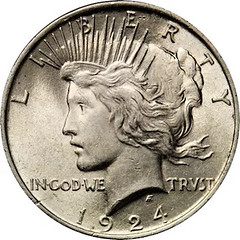 Regarding Wayne Pearson's question about the model for the Peace dollar,
Alan Luedeking writes:
Regarding Wayne Pearson's question about the model for the Peace dollar,
Alan Luedeking writes:
"I don't know whom she resembles most, but thankfully the woman on the dollar is, by far, the most beautiful of them all."
To read the earlier E-Sylum article, see:
QUERY: PEACE DOLLAR MODEL
(https://www.coinbooks.org/v24/esylum_v24n36a10.html)
On the 1987 Buddy Ebsen Sale
Regarding the Buddy Ebsen sale,
Craig Kammerer writes:
 "I was there, as I was at all Superior auctions, from their beginning, thru 1988, when I moved back to NJ.
"I was there, as I was at all Superior auctions, from their beginning, thru 1988, when I moved back to NJ.
"Buddy was at the sale of his collection & a gracious host. I talked one on one with him for quite a few minutes.
"He was lamenting the fact that he was paid very little compared to stars of TV show being paid today. He mentioned that the last episode of Barnaby Jones, his last major series, was only $150,000 per episode for him, the star. Contrast that with the fact that Jerry Seinfeld, was paid multimillions per episode, only a few years later.
"I sadly neglected to ask Buddy to sign my catalog. A true icon of show business, he was asked to play the Tinman in The Wizard of Oz but could not, due to illness."
Well, Jerry was also the writer, producer and major owner of his show, together with Larry David. But it's true that even an "average" TV show star makes much more today. Yet $150,000 for just one episode is far more than most audience members would have made in a year. -Editor
Craig adds:
"I had met Buddy Ebsen before his coin sale, as well as all the cast of the Beverly Hillbillies [Jethro—Max Baer, Ellie May—Donna Douglas, Granny—Irene Ryan], when they all came to a UCLA fair in 1971, just as the show ended [1962-1971]. It was enjoyable as we got to talk with all. I was just ending my graduate school at UCLA, when I earned my Doctoral degree.
"My other show business thrill, was when I got to interview, for about an hour, Moe Howard, leader of the Three Stooges. This was in 1972, when I was writing my Doctoral thesis. None of us knew, at the time, that Moe was to pass away of lung cancer, in 1975, not long after his colleague, Larry Fine also passed away."
To read the earlier E-Sylum article, see:
COLLECTOR BUDDY EBSEN DANCES A JIG
(https://www.coinbooks.org/v24/esylum_v24n36a15.html)
Multi-Generation Numismatic Families
Alan V. Weinberg writes:
"Regarding the image of William T. Anton, Senior’s post card, I’m probably one of the few surviving numismatists, other than Harvey Stack, who remembered Bill, Sr. During my high school summers, I worked for Bill, Sr at his home construction site. It was grueling work - the 1st week I
thought I can’t do this
but I persevered and by the 2nd week I was tossing wheelbarrows full of construction debris like they were toys. I still have my Anton scar
on my wrist from putting my hand thru a window.
"Aside from the Garrett Family of 3-4 generations, is there any other American Family that can boast three generations of serious numismatists like the Anton Family? (I think the Norwebs only have 2 generations). Bill III is seriously carrying on Bill Jr’s numismatic pursuits while auctioning duplicates and series of collections Bill Jr collected but in which Bill III has no interest. I knew Bill Jr very well and he, Dick Picker and the ANS’s then curator Hillel Kaslove’s tutelage (who is in his mid 80’s in Canada) are equally responsible for me still being a serious collector as I fast approach 78."
Great question. I thought of NBS Past President Marc Ricard, and Alan clarified that rather than families where the grandparent, parent and grandchildren still collect, he was referring to major US numismatic collections still intact into the 3rd generation. -Editor
Marc writes:
"My great-great grandfather was J.C. Lighthouse, who passed away in 1909, was an early member of the A.N.A. and had a large collection of U.S. coins. My great uncle was Charles N. Ricard was a founding member of the Token and Medal Society and an officer in the Cleveland Coin Club. My father was Charles J. Ricard, 60-year member and ANA Farran Zerbe Award winner with J.C. Lighthouse and Charles N. Ricard. I am a Past President of the Numismatic Bibliomania Society and a Board member of TAMS. I am a numismatic literature specialist and a collector of portrait medals. So if I am considering the generations correctly, the Lighthouse-Ricard family has four generations of serious numismatists.
"My great-grandmother received coins from the Lighthouse Collection, which my grandmother retained in her collection until her death. My father then inherited those from her. Upon his death, I received those selections from my dad. Those pieces remain in my collection."
Alan adds:
"Ah yes, the Stack Family with Morton & Joseph, Harvey/ Norman and Larry Stack. But Morton & Joseph were not collectors, just dealers, Norman only was a significant US type collector and Larry was a major collector of US type & English hammered but he has sold his collections."
Great topic. What other families around the world have retained their numismatic holdings across multiple generations? Queen Elizabeth II has a family stamp collection; are there more such numismatic collections? -Editor
To read the earlier E-Sylum article, see:
HOMREN NUMISMATIC POSTCARDS ON NNP
(https://www.coinbooks.org/v24/esylum_v24n36a06.html)
The Caduceus and the Rod of Asclepius
Regarding Wayne Pearson's proposal for a new coin design with a caduceus,
Peter Jones MD writes:
"This brings up an interesting point. The rod of Asclepius, not the caduceus represents medicine.
"The caduceus (a winged rod with two snakes winding around it) is the traditional staff of Hermes (Mecury in Roman mythology). Hermes is a herald and messenger of the gods, and protects travellers, thieves, and merchants. With his winged sandals, Hermes can move quickly between heaven and earth. Some of his attributes are the caduceus, winged sandals and helmet, a rooster, a tortoise, and a satchel.
"The sign for medicine was not originally the caduceus, but the rod of Asclepius, with a single snake and no wings. Asclepius was the Greek god of healing and medicine.
"In 1856 the US army hospital stewards sported a caduceus on their chevrons.
"In 1871, the Surgeon General designated the caduceus on the seal of the US Public Health Service. In 1902, the US Army Medical department adoped it despite this controversy about its significance. Those in favor pointed to the neutrality of merchant ships acting as hopspital ships which often flew a caduceus. Also, merchants supplying soldiers, were themselves neutral, like the medical corps. The medical corps wanted to portray itself as a neutral merchant. Thus the US ambulance service used the caduceus rather than the correct rod of Asclepius as an ensignia. And the rest is history!"
Thank you! Interesting history. -Editor
To read the earlier E-Sylum article, see:
PROPOSAL: CADUCEUS COIN DESIGN
(https://www.coinbooks.org/v24/esylum_v24n36a09.html)
The Chubbuck Telegraph Token and American Morse Code
Peter Jones writes:
"As a previous ham radio operator, I noticed that several Morse code letters on the reverse of the Chubbuck Telegraph token looked wrong. This led to a little research:
"Samuel Morse invented the electric telegraph in 1832 and in 1838 produced a standard code to communicate by telegraphy.
"American Morse code, standardized in 1844, developed among railroad telegraphers, also called railroad Morse, further developed by Samuel Morse and Alfred Vail.
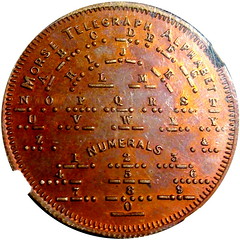 "People called it American because the rest of the world later changed. First, the German Friedrich Gerke, changed it in 1848, eliminating spacing within letters, allowing only dots and dashes.
Then in 1865 the International Telecommunication Union changed the code again to account for different character frequencies in other languages. This is the code we know today.
"People called it American because the rest of the world later changed. First, the German Friedrich Gerke, changed it in 1848, eliminating spacing within letters, allowing only dots and dashes.
Then in 1865 the International Telecommunication Union changed the code again to account for different character frequencies in other languages. This is the code we know today.
"The Chubbuck Telegraph Token, issued in the 1850s correctly illustrated American Morse code from 1844 ("railroad Morse"). Eleven letters of the alphabet, and nine of ten numerals are different in today's International Morse code when compared to railroad Morse."
More great history! Thanks. -Editor
To read the earlier E-Sylum article, see:
S.W. CHUBBUCK AND THE BEETHOVEN EFFECT
(https://www.coinbooks.org/v24/esylum_v24n36a26.html)
More Duplicate Money-Lender Image Book Covers
Regarding our discussion of twin and triple numismatic book covers, Ron Haller-Williams writes:
"You ended up commenting, "I guess I wouldn't be surprised if more examples turn up." I've now stumbled across two more."
While not entirely numismatic in nature, it's still interesting to see how universally accepted the image is. Ron also supplied two related book covers. Thanks! -Editor
Ron writes:
"The first one is rather different, although the picture is on a very similar theme. The second one uses a detail from the first."
Ron also discovered the images on stamps. Nice! -Editor
To read the earlier E-Sylum article, see:
NOTES FROM E-SYLUM READERS: SEPTEMBER 5, 2021 : Triple Book Covers
(https://www.coinbooks.org/v24/esylum_v24n36a08.html)
Selling the $7.68 million 1804 Silver Dollar
Ron Guth writes:
"Here's a new YouTube video I posted about the $7.68 million 1804 Silver Dollar. There were only three of us in the audience, and I don't know if Stack's/Bowers posted their own video, but there can't be too many video records of the event."
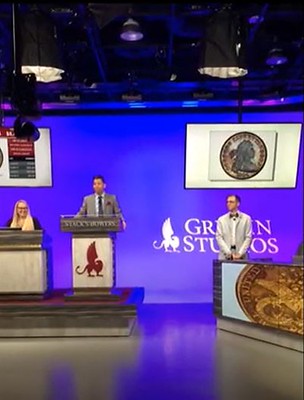 On August 17, 2021, Stack's/Bowers sold the finest known 1804 Silver Dollar for a record $7,680,000. I was there in the Stack's/Bowers production studio to record the event so that you could enjoy it, too. You'll see the starting bid, the increments, and the moment the hammer fell
On August 17, 2021, Stack's/Bowers sold the finest known 1804 Silver Dollar for a record $7,680,000. I was there in the Stack's/Bowers production studio to record the event so that you could enjoy it, too. You'll see the starting bid, the increments, and the moment the hammer fell
As auctions moved online, this was the inevitable result. Where once there were throngs of participants and peanut-gallery occupants, there are now empty chairs. The people are still there, only online from elsewhere. A very different experience. -Editor
To watch the video, see:
Ron Guth on Coins - Stack's Bowers Sells 1804 Silver Dollar
(https://www.youtube.com/watch?v=3x5nDr6BoFw)
THOUGHTS ON THE ANNIVERSARY OF 9/11
Reader Etienne LePen submitted these thoughts on the anniversary of 9/11. Thanks. -Editor
After years at the Sheraton, the New York International moved downtown to an attractive lower floor in the World Trade Center (as can be noted in the background of this picture).
At the WTC - Miquel Pratt of Paraguay, Joe & Lee Firester, Elon Malis of Israel, Peter Last, and the Pomexport group (Judith, Steve & young Alan - who occasionally prepares E-Sylum advertisements).
A few weeks before the attacks, a German associate, Peter and I were heading down to the ANA in Atlanta, and had a rather strange check-in at Newark Airport. The security lady was a Pakistani who spent an inordinate amount of time going thru every coin flip and each individual banknote. After about 25 minutes of this craziness, I asked if she was looking for something specific and she said - no. In the hopes of speeding up the process, so as not to miss our flight and with the idea that the attention may be drawn away from my innocuous numismatic material, I asked if it was OK that my buddy was carrying a 12" Bowie knife, to which she said - no problem. If that was security, something was wrong.
My associate, Peter, being German was very punctual, but on 9/11 he did not show up as usual; that was strange as it was a short bus ride from Manhattan (where he lived) to my office in NJ. Peter finally arrived and said that there was some commotion in the city, but suggested we look out the window as we had a clear view to the City. Surprisingly all we could see was smoke. Later that day we became aware of the horrendous attacks.
Although we debated heavily, that weekend we set up at the Smythe Show in PA and met with several friends who had survived the ordeal (although we did know the brother of a collectibles dealer who was on one of the planes). To us who were not alive during WW2, 9/11 was really the day that will live in infamy.
It seemed ominous that this New York Telephone card had the white band shown at this level of the towers.
Thank you. Here are links to some articles published after the event. -Editor
Eric Cheung wrote:
"I live down around City Hall in Manhattan and it's a pretty commercial area; at this time in the morning there's normally quite some commotion down here particularly since everyone is trying to get to work.
"I just heard a rumble that was about twenty seconds long. ... A couple minutes later, my mom came into my room and told me a plane just crashed into the World Trade Center.
"In utter disbelief, I kicked out of my bedsheets and looked out the window and saw lots of people running around in the streets heading up Broadway away from the explosion. I also checked out the living room and saw CNN extensively covering this disaster.
"About eight or ten minutes later, ... I heard a huge explosion as the legs of my bed and the floor of my 9th floor apartment shook.
"The first world trade center collapsed down to the bottom...
"I walked not ten feet from my neighbor's apartment when I heard an even louder rumble. My neighbors summoned me to return to the apartment, and in the last second as I dashed to the window, I saw the final section of World Trade Center 2 tumble straight down into the ground. My neighbors and mother were hysterical. Moments later the debris and ash of the aftermath rose into the blazingly sunny sky.
"I returned to my apartment about 10:28, the hallways in my building filling with smoke. I continued down the hallway where there are windows every ten feet or so, four or five in all down about a hundred feet corridor. There was white dust atop every roof I could see, and it looked like a snowstorm had just hit us, or radioactive waste from a nuclear explosion had just rained down upon us. After a while, the two look the same, and are both frightening and frustrating in equal magnitude."
To read the earlier E-Sylum articles, see:
SEPTEMBER 11
(https://www.coinbooks.org/esylum_v04n38a02.html)
AMERICAN NUMISMATIC SOCIETY EFFECTS
(https://www.coinbooks.org/esylum_v04n38a03.html)
AUCTIONS RESCHEDULED
(https://www.coinbooks.org/esylum_v04n38a05.html)
NEW YORK NUMISMATIC CLUB MEETING RESCHEDULED
(https://www.coinbooks.org/esylum_v04n38a06.html)
INDEXING VS. IMAGING THE NUMISMATIST
While searching for other things I came across an interesting article from the May 1994 issue of The Numismatist discussing the pros and cons of issuing a CD-ROM of back issues of the publication vs creating a printed index. In a world where everything seems to have been digitized and made searchable online, it's an interesting view of the state of technology some 27 years ago. -Editor
The Case for Imaging, by Brandon Dennings
 I HAVE HEARD that the ANA is kicking around the idea of capturing every issue of The Numismatist on CD-ROM. I, for one, think it’s a great idea. Microfilm and printed indexes can’t compare to having 100-plus years of this historic, numismatic journal at your fingertips.
I HAVE HEARD that the ANA is kicking around the idea of capturing every issue of The Numismatist on CD-ROM. I, for one, think it’s a great idea. Microfilm and printed indexes can’t compare to having 100-plus years of this historic, numismatic journal at your fingertips.
Although this would be no small task with regard to finances or time, entire issues of The Numismatist on CD-ROM could prove immensely valuable to numismatic researchers. Equipped with a CD-ROM player, you could, for example, pop in a disk and instruct the unit to search for every mention of the 1804 dollar. It would flag not only news items and feature articles, but advertisements as well. (A printed index would include just editorial material, not advertising.)
And how about the ANA member who wants a complete set of The Numismatist but can’t afford the shelf space or the price, which can run thousands of dollars? A CD-ROM collection of all the volumes (text only) could be made available to ANA members for less than $500.
In this day and age of electronic information, ignoring the possibilities of indexing
The Numismatist on CD-ROM would be a sin. Publishing houses have squeezed dictionaries and entire sets of encyclopedias on disk using CD-ROM technology.
The Case for Indexing, by William Gilbert
THIS YEAR MARKS the 107th volume of The Numismatist, but surprisingly the last time a cumulative index was published was 1978, more than 15 years ago. The magazine’s 100th anniversary in 1988 (or the Association’s centennial in 1991) would have been a perfect time to create a new, improved index.
However, it is not too late. I would welcome a comprehensive, cross-referenced index of every article, author and subject that has appeared in The Numismatist since its debut more than a century ago. Without an up-to-date index, all the valuable information contained in the magazine’s pages is useless.
Despite all the discussion that print has become an obsolete mode of communication with the advent of computer and CD-ROM technology, I think a printed index would be of the greatest use to ANA members. True, such an index might be a bit ungainly, easily comprising 1,500 pages or more, but it would be great to keep on the bookshelf with my volumes of The Numismatist.
A printed reference is always accessible; you do not need expensive, complicated equipment to use it. In addition, I suspect that many ANA members do not have CD-ROM players — or even computers — in their homes.
Andy Newman writes:
"And here we are, over a quarter-century later, with technological progress yielding dramatically
- better image quality
- lower cost, and
- easier access."
Len Augsburger writes:
"As I recall legal concerns were raised following publication of this notice. Did the ANA have the right to provide electronic access to The Numismatist, without explicit permission from the individual article authors? The law, by definition, always lags new technology. At some point the ANA solicited authors for permission to distribute their content electronically. I doubt that authors universally consented. In the end, the Exact Editions online copy of The Numismatist went live in 2015.
"A different form of this question was raised in the 1930s. Should the ANA reprint the (rare) first six volumes of The Numismatist, in order to provide wider access to collectors? The Chicago collector, William Dunham, who owned a copy, called the idea an injustice
to the fortunate few who possessed copies. We now have poetic justice
– Dunham’s copy was eventually acquired by Eric Newman, and, long out of copyright, scanned in 2016 by the Newman Portal."
Handmade indexes are a wonderful tool, and still of great use. Yet they are time-consuming and expensive to create, and immediately out of date. Search engines can help users find electronic content at scale, but are far from perfect and users are often overwhelmed by the number of results returned. A perfect answer to the problem may not yet exist. However, I do find myself sometimes reaching for Dave Bowers' centennial history of the ANA and looking in its hand-compiled printed index to locate articles about particular people or topics. -Editor
VOCABULARY TERM: FINISH AND FINISHING, PART 2
Here's the second and final part of Dick Johnson's Encyclopedia of Coin and Medal Terminology entry on Finish and Finishing. -Editor
Oxidation (actually a sulphatization). The wire basket containing the abrasive-blasted medals are then immersed in a bucket containing the darkening chemical (as ammonium sulfide) for the next step of antiquing. The wire basket is rotated by hand holding the handle, swishing it around submerged in the liquid so it comes in contact with as much of every medal's surface as possible.
Time is quite critical. The chemical acts quickly. The medals turn black almost immediately. The sulfur from the ammonium sulfide combines with the surface molecules of the bronze or silver to form copper sulfide or silver sulfide. The metal reacts instantly with the sulfide, the process of sulphatization (unfortunately it is called oxidation, which implies oxygen, but the reactive ingredient is the sulphur, no oxygen is required). This chemical action occurs in from five to ten seconds.
The medals are again changed in color (as well as their surface changed chemically). From gray abrasive blasted, they are now black. The operator can control the blackening somewhat. In the first few seconds bronze turns dark brown, then black (silver turns black immediately). The longer the medals are left in the solution, the darker (blacker) they become, reaching a maximum blackness in the ten seconds.
The wire basket containing the medals is removed from the bucket containing the darkener and immediately immersed in water. This stops the chemical action. Then fresh water is run over the medals to wash away any remaining darkening chemical, and any residual abrasive. The wet medals are removed from the wire basket, placed in a tote box and moved to the relieving station.
Relieving and highlighting. Dry ground pumice in very fine grain size is mixed with water until it has the consistency of thick soup. The operator douses a slurry of this mixture on the surface of a darkened medal while he holds it in his hand. It is then buffed by hand on a motorized muslin buffing wheel by lifting the dripping medal upwards under the rotating wheel. (The wheel is rotating counterclockwise, otherwise the operator would get a face full of slurry. A splash guard behind the buffing wheel collects the spun off slurry instead.) It is certainly understandable why this equipment is called wet wheel and the process wet-coloring.
The operator rotates the medal by hand then makes a couple of passes under the buffing wheel. The buffing action heats up the medal. By adding more pumice slurry he lowers the temperature so his fingers can control the medal. He repeats the slurry and buffing process as often as necessary for each side of the medal. Then he will buff the edge, rotating it while the revolving buffing wheel is in motion. Skill comes in handling the slippery moist medal, and not dropping it, while making an even two-tone color on both sides, with an edge to match.
The buffing wheel removes the darkened surface in areas where it can reach – flat surfaces and high areas of the detail. Since it does not touch the surface in the crevices and the corner areas it does not remove the darkened surface there. Thus the completely relieved medal would be light (the color of the original bronze or silver) on the flat and high surfaces, and the contrasting dark color in the crevices and corners.
This total process creates the light-and-dark, two-toned effect to give it its highlighted appearance. The optical effect is to make the object's relief in greatest contrast for the human eye to perceive. Highlighting accomplishes this.
Drying and lacquering. After their treatment under the wet wheel, the medals are washed under running water of all the pumice slurry. They are then laid on a flat rack accommodating a dozen or so medals to be dried. The rack is then placed under ultraviolet lights (or in an oven) to completely remove all moisture.
Moisture is the enemy of the next step – lacquering. A wet spot, the tiniest bit of water, or a person sneezing on the medal's dry surface, will, in time, cause dark spots to form on the medal's surface under the lacquer (it is even called water spot). Every effort is made to dry the medals thoroughly, both sides, then get them in the lacquer spray booth at once. The rack is laid on a turntable in the spray booth. A spray gun – the best method
For applying lacquer – is passed over the medals once back and forth. The rack is rotated one quarter turn. The medals are sprayed again, once. Thus the medals have received the minimum amount of lacquer but in two directions, once horizontal, once vertically.
This thin coating of lacquer is perfect. It is so thin (less than a few thousandths of an inch) it cannot be seen with the naked eye. With any additional spraying the lacquer would build up in the corners and be unsightly. Dipping causes this more so, and brushing (the only other ways of applying lacquer) leaves brush marks. Spraying is ideal.
Applying the light lacquer coating while the medals are still warm from their heat lamp drying treatment will give a matte appearance to their surface. If a glossy finish is desired additional passes of the spray gun with a heavier coating will increase the reflectiveness to give the surface a shinny appearance.
The lacquer is usually clear. However, the lacquer can be colored, by adding metal powders (bronze powders), dyes or tints. Thus the spraying can keep the color of previous metal coloring (with transparent lacquer), or change it drastically, or only slightly.
With one side of the medals sprayed both directions, an empty rack is placed over the medals, and by holding the two racks tightly together, the operator can flip this over, to lay the second rack on the turntable and spray the second side of the medals. The lacquer drys almost instantly, the finishing of the medals are now complete and need only to be carried to the next workstation for any mounting, fabricating, edge lettering or numbering, or for inspection and packaging.
Imitating gold and silver. Not surprising, a lot of the activity in the finishing department is to make metal objects appear more attractive or desirable. Base metal items are often desired to be colored gold or silver. Undoubtedly this is a carry over from the jewelry field where so many of these processes were developed. Objects are struck or cast in base metals for the lower metal cost and given a surface, or coating, or finish, to appear as the more expensive noble metals.
While some metal compositions are chosen to imitate gold – brass, goldene, oroide – several methods imitate gold with layering (as rolled gold), clad, or electroplating with the outer layer actually gold. nickel silver is a composition in imitation of fine silver. But silver can even be imitated with silver wash, silvered, silverclad, and silverplate. The finishing department must be able to work with all of these, but most often utilizes gold and silver plating.
Electroplating. A well equipped finishing department for medal manufacturing will require both gold and silver electroplating tanks. These are used for finishing medallic items with the required surface color by plating. Usually, because the finishing foreman has the knowledge of electrolysis, he is also in charge of making galvanos by electrolysis even though this is a production of the item, not just the finishing (unless the galvano is required in a further production step, as a dieshell, in which case it is not required to be finished).
Medallic items to be plated are placed on racks which are immersed in the electrolyte solution. Anodes of the pure medal – gold or silver – are also in the solution. The items to be plated are the cathode. Electric current is turned on and, by the process of electrolysis, the metal is leached from the anodes and deposits on the cathode (the medallic items). A further description of this process is given under the entry on electroplating.
Patina finishes. While oxidizing (sulphatization) with a darkening chemical and highlighting (by relieving) is but one method of finishing a medal, a medal can also be finished with a patina. Patina finishes offer a range of surface protection – in a spectrum of possible colors! With a quantity of browns and greens for bronze items and grays and blacks for silver. The choice of a patina is an artistic one, it should be made to harmonize with the design or amplify the theme. It is often made in consultation between the sculptor or creator of the design and the finishing department foreman.
Each patina finish has its own methodology, and these techniques of application may range across a broad spectrum of activities. The variables concern: (1) the temperature of the medal, (2) the temperature of the patina solution, (3) how a solution is applied, (4) how long a solution is applied, (5) the type of applicator (if any), (6) any wet wheel application, (7) how a medal is supported while work is performed on it, (8) how the solution is allowed to set or dry, (9) pH of an acid solution, others.
There are, perhaps, forty or more commonly used patina formulas for medals. This despite the 1,126 different patinas listed in Hughes and Rowe, the standard work on patinas for the field of metal coloring. The authors recommended only 344 of these formulas and techniques.
The Society of Medalists issues, created by Medallic Art Company, all have different patina finishes up to about issue #96. Although some are slight modifications the attempt of the Society was to issue a different patina for each issue. This medal series exhibits, therefore, examples of what can be done in a modern finishing department. An even more dramatic series was the Religions of the World, issued by Presidential Art Medals in which 15 different medals, each a different religion, each with a different patina.
The entry under patina lists the colors, chemicals, and names of the more popular patinas. The reader is directed there for these specific patinas.
Enameling adds color. The finishing department must also be able to do enameling as well as other finishing processes. Enamel adds color by applying tiny colored glass beads in an enclosed area on the surface of a medallic item. The cloisonné process requires fences or sides of relief to contain these loose beads, but an astute designer can work these raised surfaces into the overall design. Separate color beads are added for each different color.
With the medal laying flat and all areas to be colored with enamel filled with loose glass beads the piece is then fired. It is placed in an oven which melts the beads which become hardened and fixed in position. Enamel is essentially colored glass applied to a metal object. It is the most ideal way to add different colors to a medallic item, the colors are permanent and solid. However, since the enamel is glass it is susceptible to breaking, particularly near the edges.
Fabricating and mounting. To complete a medallic item the finishing department is required to do any final steps in its manufacture by fabricating – bringing together any additional assembly, like placing a ribbon drape on a medal – or mounting the item, as on some other object. Further details on these can be found in the entries on fabricated and mounting.
Thus we have observed that in contrast to coins, which require no finish (that's why it's called coin finish), medals require and can be adorned with a great variety of finishes. It is the finishing department that accomplishes all these functions.
To read the complete entry on the Newman Numismatic Portal, see:
Finish and Finishing
(https://nnp.wustl.edu/library/dictionarydetail/515913)
To read the earlier E-Sylum article, see:
VOCABULARY TERM: FINISH AND FINISHING, PART 1
(https://www.coinbooks.org/v24/esylum_v24n36a11.html)
RITTENHOUSE HALF DISMES REENACTMENT
Pete Smith has a great topic and photo for us this week. -Editor
Mint Director Presenting Half Dismes
There were no cameras to record the moment when Mint Director David Rittenhouse presented a tray of the first United States coinage to Martha Washington. The only visual record was provided by paintings with varying degrees of inaccuracy.
A photo exists showing an actor portrayal of the event. The characters include Rittenhouse presenting the tray to Martha while Alexander Hamilton, Mrs. Hamilton, George Washington and Thomas Jefferson observe from the background.
This week we offer the E-Sylum Smarty-Pants Award to the first reader who can identify the actors shown in the photo. Extra points to the reader who can identify the event where the photo was taken.
Interesting question. I'm stumped and only have a partial guess. Does anyone know? -Editor
HARVEY STACK'S NUMISMATIC FAMILY, PART 104
The latest article in Harvey Stack's blog series covers 1989 and the spectre of Federal regulations for the U.S. coin industry. -Editor
1989 was a year of great growth in the numismatic hobby. Many collectors entered the field, stimulated by the Mint's advertising program that promoted Mint sets, Proof sets and special commemoratives with the line "An investment in the future." This attracted young collectors to the field and appealed to their relatives who bought them these new issues to put away for the "future." Additionally, special reports from Wall Street by Salomon Brothers showed that coins were increasing in value more rapidly than art, precious metals and other collectibles, and this too was a stimulus.
Rare coin collections that came to market in private sales and public auctions also exhibited increased value when their results were reported. Confidence in grading was encouraged by the acceptance of the new grading services who provided assurance to many buyers about what they were actually purchasing. Stack's continued to be a leader in the public coin auction market, by offering a group of extremely rare collections in the United States series, as well as foreign and ancient coins. In 1989, our firm brought to market 13 separate catalogs in as many sale events. Established collectors had great opportunities to add to their collections and they participated enthusiastically, in many cases establishing new record prices. In order to prepare for this growth in the hobby, which we at Stack's had anticipated, our staff had been increased by professional numismatists in all fields.
While my father, Morton, my Uncle Joseph and my cousin Ben had passed away, the Stack family continued to be represented by me, my cousin Norman, and my son Larry among the numismatists, while my daughter Susan was in charge of bookkeeping and, eventually, my granddaughter Rebecca also came to work for the firm. Besides our family, we made sure we had an extensive staff, all of whom were committed to creating exciting sales and informative catalogs. Stack's reputation in the field and our ability to attract experts to work with us meant that over the years the staff at Stack's would include some of the most famous names in numismatics. This had been true in decades past and continued to be true in 1989 and as we made our way into the last decade of the 20th century. With Larry, Norman and myself and the great help of those who worked with us, we were able to maintain our leadership in the industry and help it grow.
In 1989, I became president of the Professional Numismatists Guild (PNG), after serving more than a decade on the Board. I was proud that when we were challenged by the Federal Trade Commission, (FTC) regarding the possibility of having dealers all licensed by the FTC and ruled by very strict rules and restrictions, I was chosen to debate the Commissioner at a public coin show. The Metropolitan New York Convention in May of 1989 was the place selected. It was a big challenge and I, together with a colleague, were part of the dealer team, while the FTC was being represented by Director Barry Cutler and his New England office representative. The debate was surely important as the new licensing proposed by the FTC would hamper the coin industry as it had functioned for many years.
Of course, the FTC was trying to address real problems in the coin industry, including counterfeits that were being offered in ads and on convention floors, the misgrading of coins and false representations of rarity and value that were being used by "promoters" to take advantage of those who didn't know better. There was bad advice being given, coin packages being sold and not delivered, and other dealings that were wrong and illegal. I selected Luis Vigdor, manager of the banking house of Manfra, Tordella, and Brooks in New York as my partner for the debate. Besides being a great numismatist, Luis dealt in bullion related coins, and understood buying and selling in that market. This was the support that I felt I needed to make my case for the hobby's professional dealers, auctioneers and of course the "mom and pop" small shops all about the country.
Fortunately, I also had a great relationship with Coin World, and Margo Russell and Beth Deisher of that publication offered to do research for me to reinforce my position on regulations of the hobby business. They spent lots of time researching the hobby, and sent me many pages of evidence showing that the coin industry did not have to be regulated as were other "second-hand dealerships" like hock shops, pawnshops, jewelers, bullion dealers and refiners. As you will see in my next article, their research helped win the argument that I was to present for our industry.
To read the complete article, see:
Harvey Stack Remembers: Growing up in a Numismatic Family, Part 104
(https://www.stacksbowers.com/News/Pages/Blogs.aspx?ArticleID=harvey-stack-remembers-104)
To read the earlier E-Sylum article, see:
HARVEY STACK'S NUMISMATIC FAMILY, PART 103
(https://www.coinbooks.org/v24/esylum_v24n35a20.html)
CHRISTOPHER COMBER (1944-2019)
Later this month St James’s Auctions in London is selling the remarkable collection of Elizabeth I coins formed by Christopher Comber. With permission, we're republishing his biography from the September 23, 2021 catalogue. -Editor
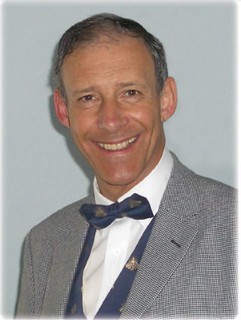 Chris was born in New Cross, south east London, the only child of Arthur and Julia Comber on 27th October 1944. He attended Haberdashers’ Aske’s boys’ school and was a proud Old Askean. In later years he continued to enjoy life to the full despite some health issues, enjoying family occasions and contributing to British Association of Numismatic Societies Congresses with his characteristic enthusiasm. Chris died on 2nd February 2019 aged 74.
Chris was born in New Cross, south east London, the only child of Arthur and Julia Comber on 27th October 1944. He attended Haberdashers’ Aske’s boys’ school and was a proud Old Askean. In later years he continued to enjoy life to the full despite some health issues, enjoying family occasions and contributing to British Association of Numismatic Societies Congresses with his characteristic enthusiasm. Chris died on 2nd February 2019 aged 74.
Chris entered the world of marine insurance as a chartered average adjuster in 1963 and rapidly became very well respected in his field. Chris married Rita in 1971 and they went on to have two children, Matt and Franki. Chris loved music, with tastes ranging from traditional country and western to early rock ‘n’ roll. He was an accomplished singer and guitar player and during the 1960s and 70s performed in London bars and clubs. Chris recorded three albums of old-time country music produced by a German record label, leading to him and his music partner conducting a tour of German folk festivals in the mid-1970s.
Chris’s interest in coins began in the summer of 1957 when, at the age of 12, he had a chance encounter with a 1568 Elizabeth I sixpence he saw in a shop window while on holiday in Swanage. Successfully persuading his parents of the benefits of paying over eight shillings for a sixpence, this coin became the foundation of the collection now being presented for sale by St James’s Auctions.
A passionate numismatist, Chris researched his subject meticulously and went on to produce The Hammered Silver Coins Produced at the Tower Mint during the Reign of Elizabeth I in partnership with I. D. Brown and W. Wilkinson that has become a recognised reference document for the silver coinage of Elizabeth I. His talks on subjects such as The Pattern Shillings of Elizabeth I, The Trade Coinage of Elizabeth I and The Irish Harp coinages of Henry VIII were a highlight of the numismatic circuit. These talks were renowned for their accuracy and detail and were complemented by the display of the actual, often unique, examples of the coins described, brought from his own collection.
Chris was devoted to his wife and family and loved spending time with his children and four grandchildren. Chris will be remembered by all who knew him for his generosity, unassuming manner, sense of humour, vast numismatic knowledge and his notoriously extravagant waistcoats.
In this series of auctions, Chris’s family and St James’s Auctions are proud to present the fi nest collection of Elizabeth I coins and related Tudor pieces ever formed.
For more information, see:
https://stjauctions.com/
URAM CONCLUDES TWO TERMS ON THE CCAC
Louis Golino published a Coin Update article on Tom Uram, who recently concluded two terms on the CCAC. Here's an excerpt - see the complete article online. -Editor
 Thomas J. Uram, a 30-year financial services industry veteran and coin collector for the past 50 years, recently ended his second term on the Citizens Coinage Advisory Committee in the position that is recommended by the Speaker of the House of Representatives. His tenure began in 2012 and included two years serving as chairman of this important group that reviews the designs that appear on all U.S. coins, including circulating, bullion, commemorative coins, and congressional gold medals.
Thomas J. Uram, a 30-year financial services industry veteran and coin collector for the past 50 years, recently ended his second term on the Citizens Coinage Advisory Committee in the position that is recommended by the Speaker of the House of Representatives. His tenure began in 2012 and included two years serving as chairman of this important group that reviews the designs that appear on all U.S. coins, including circulating, bullion, commemorative coins, and congressional gold medals.
His second term on the committee formally ended on January 28. His successor is Dr. Harcourt Fuller, a historian of Africa who teaches at Georgia State University.
Tom, who started collecting Lincoln cents in 1971, first joined the ANA in 1974 and two years later became a life member. He has long been a major hobby leader having served for the past decade as president of one of the most important state-based coin clubs, the Pennsylvania Association of Numismatists that holds three major coin shows a year; is a former member of the ANA’s Board of Governors (2017-2019); and is also active in many other numismatic groups and associations. In 2018 he also ran but lost in a bid to become ANA vice president.
Throughout his extended term on the committee, he demonstrated the importance of having a lifelong coin collector on the group that plays such an important role in the process of creating U.S. coins.
 And Tom has been especially active on the committee being personally responsible (along with fellow CCAC member and numismatic researcher and award-winning author Michael Moran) for coming up with the idea and then working to ensure passage of congressional legislation that authorized the 2021 Morgan and Peace dollar coin program, which marks the centennial since the issuance of the final Morgan and first Peace dollar in 1921 and is now expected to become an ongoing U.S. Mint series.
And Tom has been especially active on the committee being personally responsible (along with fellow CCAC member and numismatic researcher and award-winning author Michael Moran) for coming up with the idea and then working to ensure passage of congressional legislation that authorized the 2021 Morgan and Peace dollar coin program, which marks the centennial since the issuance of the final Morgan and first Peace dollar in 1921 and is now expected to become an ongoing U.S. Mint series.
He also played an important role in the 2019 Apollo 11 50th anniversary commemorative program, including serving on the panel of judges who selected the obverse design by Gary Cooper that won the design competition. That coin program was the brainchild of another former CCAC member, Michael Olson. The five-ounce silver Proof Apollo coin was named 2021 Coin of the Year.
Towards the end of his second term, Tom created a subgroup within the CCAC to make recommendations on commemorative coinage.
During his tenure on the CCAC, Tom clearly had a significant impact shaping American coins and medals, especially by helping to create some of the most popular and successful coin programs of recent years, and his colleagues on the committee and at the U.S. Mint will undoubtedly miss him and his collegial style of leadership.
To read the complete article, see:
Thomas Uram concludes a memorable double term on the CCAC
(http://news.coinupdate.com/thomas-uram-concludes-a-memorable-double-term-on-the-ccac/?sfw=pass1631387074)
To read a related article, see:
NGC signs exclusive Signature Label deal with Thomas J. Uram
(https://news.coinupdate.com/ngc-signs-exclusive-signature-label-deal-with-thomas-j-uram/)
ARCHIVES INTERNATIONAL AUCTION 70
Here is the announcement for the September 22, 2021 sale by Archives International Auctions. -Editor
ARCHIVES INTERNATIONAL AUCTIONS OFFERS HUNDREDS OF HISTORIC U.S., CHINESE AND WORLD BANKNOTES, SCRIPOPHILY & HISTORIC EPHEMERA ON SEPTEMBER 22nd , 2021.
The auction will be held by Archives International Auctions at their offices in River Edge, N.J.
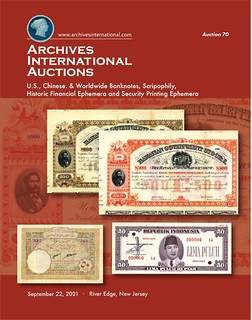 The September 22, 2021 auction by Archives International Auctions is
highlighted by hundreds of rare and desirable banknotes, scripophily and historic U.S. Colonial and U.S documents rarely seen at auction. The Auction 70 catalog will consist of 878 lots of rare and desirable U.S., Chinese & World Banknotes, Scripophily, Historic Financial Ephemera and Security Printing Ephemera.
The September 22, 2021 auction by Archives International Auctions is
highlighted by hundreds of rare and desirable banknotes, scripophily and historic U.S. Colonial and U.S documents rarely seen at auction. The Auction 70 catalog will consist of 878 lots of rare and desirable U.S., Chinese & World Banknotes, Scripophily, Historic Financial Ephemera and Security Printing Ephemera.
We are excited to offer early U.S. and Colonial fiscal documents from a new find as well as banknotes, bonds and shares that have been off the market for decades or are new to the collecting world
, stated Dr. Robert Schwartz, President of Archives International Auctions. Included in the upcoming auction are rare and desirable numismatic items that will enhance the collections of every level of collector and dealer
.
The auction is highlighted by 31 Colonial and Revolutionary U.S. period fiscal documents from a new find. The section begins with a 1753 Pennsylvania Land Deed signed by Simon Matthews, One of the founding fathers of Chalfont, Pennsylvania. Additional pre and post-Independence colonial documents include pay warrants for paying widows of P.O.W.’s captured during the war; payments to Company Commanders to pay bounties to men to enlist in their Battalions; Promissory notes signed by Oliver Ellsworth, Oliver Wolcott and other revolutionary war notables as well as Continental Army and State of Connecticut Pay Table warrants signed by Fenn Wadsworth, Revolutionary War General and other early U.S. founding notables.
World Banknotes are highlighted by over 300 rare notes from old estates and collectionsincluding the Allen Berk Collection. One of the many highlights in the auction features a desirable Lebanon, Banque de Syrie et du Grand-Liban, 25 Piastres, P-2 in VF condition; China is represented by over 30 lots of banknotes and 14 lots of Bonds; A rare and very desirable Palestine, 1 Pound, 1927 banknote rarity is offered; There are 30 lots of Russian issues dating from 1898 to 1961 with many high grade examples offered; High grade African notes are offered including a Senegal, West Africa, 5000 Francs note that grades PMG Gem Unc 65 EPQ.
Also included are hundreds of rare and desirable banknotes with many interesting group lots from an old-time dealer’s stock as well as items from old estate collections and consignments.
The U.S. section begins with 31 lots of desirable Colonial and Early U.S. Revolutionary period fiscal documents from a new find. The Colonial section is followed by 14 lots of Obsolete and Fractional banknotes followed by 19 lots of U.S. Small and Large National banknotes, highlighted by a rare Catskills bank, The Home National Bank of Ellenville, New York, $10, 1929 Type 1 with only 9 small notes known on the bank; 3 different 1929 small type from Florida banks including the Exchange National Bank of Tampa, Series of 1929, Type 2; additional Southern and South Eastern notes from Georgia, Louisiana, Mississippi, Tennessee, and West Virginia; Other Nationals include notes from Minnesota, New York, Utah, and Oregon, highlighted by a forbidden title United States National Bank of Portland, $20, Series of 1902 PB in Choice VF condition. An attractive $1,000 F.R.N., Cleveland, Ohio, Series of 1934-A, District D, in VF- Choice VF condition is offered and is sure to attract attention. 4 Lots of 1907 and 1933 Depression Scrip are offered followed by 2 lots of M.P.C. highlighted by a Vietnam War
Turnkey Commissary Receipt
Scrip note Specimen with production related items that was issued by a private and Government appointed contractor to build airports in Vietnam during the war.
The Security Printing Ephemera section includes 30 lots of rare and desirable items including production proofs, vignettes, advertising pieces and related items. Highlights include an 1837, Burton & Gurley Bank Note Engravers Proof Advertising sheet; a proof Continental Bank Note Company business card-Letterhead; an 1870, Heath’s Infallible Counterfeit Detector at Sight with 11 engraved plates; a Reed, Stiles, Pelton & Co., Banknote Engravers Advertising note; and numerous additional desirable and rare items. The Security Printing Ephemera section is followed by 14 lots of U.S. & World checks, drafts and exchanges dating from the 1850’s to the early 1900’s. Historic Ephemera follows with 43 lots of rarely seen and desirable items including and 1863, New York, Application for a drafted persons Civil War Substitute paying the substitute $300 as well as a second example of a person volunteering as a substitute soldier for $300; a Selma, Alabama, 1863 Confederate States letter regarding slave purchases for $26 per month by the government (C.S.A.) for use at the Shelby Iron Works; a historic 1865 Union Army Discharge Certificate for Robert Brown, a Black Private in the 2 nd Louisiana Native Guards which was given at Ship Island, Mississippi; an outstanding Civil War, 1862-63 Application for Prize Money for Ship Captures and Naval Discharge Papers with additional supporting documents (4); a City of New York, 1865 William
Boss
Tweed signed document for supplies and cleaning public offices; and, numerous other interesting and rare historic documents and ephemera.
U.S. Federal Bonds, Liberty Loans and U.S. & Hawaiian Fiscal Documents and Bonds include 9 lots highlighted by an extremely rare and attractive pair of 1882, Hawaiian Government Stock
Bonds for $100 and $500 with partial coupons included. Each has a portrait of King Kalakaua at the left with the Hawaii arms in the middle, with coupons attached at the bottom. There are portions where the folds have been archivally reinforced to protect from splitting. Rare and attractive bonds with no more than 2 or 3 printed of each bond.
The U.S. and World Scripophily session will include 319 scripophily lots including the topics of Automobiles, Railroads, Transportation, Banking and Finance, World, Famous names, and many other desirable topics. Highlights of the scripophily section includes a 1996 Specimen Berkshire Hathaway, stock certificate with a Warren Buffett facsimile signature; 2 different Standard Oil Trust certificates dated 1882 and signed by J.D. Rockefeller; an American Express, 1873 stock certificate signed by William Fargo and Henry Wells; a Lehman Brothers Holdings specimen stock certificate; a 1988 Apple Computer Specimen stock certificate; over 80 lots of World Scripophily highlighted by an issued Maritime Canal Company of Nicaragua bond for $100 by ABNC; an 1890, Ferrocarril Nacional De Tehuantepec, Oaxaca, Mexico, Specimen Railroad Bond, possibly unique; a unique Ecuador, Compania de Ferrocarril de Guayaquil, 1888 Specimen bond; and, numerous other desirable and rare World bonds and Shares. The world section is followed by mining, navigation, oil and gas, railroads, and additional topics with highlights including a 1912, General Electric specimen bond rarity; and an 1855, Michigan, Stonington Mining Co., Issued and uncancelled stock certificate. There are over 180 railroad bonds and shares highlighted by an Alaska, Council City & Solomon River Railroad Co., 1905 I/U stock certificate rarity; an amazing and unique, 1889, Saint Paul City Railway Co., $500 Specimen bond with a horse pulled train on top; and dozens of additional outstanding bonds and shares from numerous different topics.
Previews will be limited and by appointment only and we will be observing strict safety precautions including the wearing of masks and observing social distancing to protect our team as well as our guests. We will do our best to accommodate anyone who desires additional information and photographs. For questions, please call 201-944-4800 or email info@archivesinternational.com.
The online catalog for the Wednesday, September 22 nd , 2021 auction is on Archives International Auctions’ website and can be viewed via the Archives International live bidding platform. It can also be viewed as a Virtual Catalog or downloadable Sale 70.pdf on their website. To pre-register for Live Internet Bidding, log on to the Archives International Auctions website, at www.ArchivesInternational.com.
Archives International is now working on their Fall and Winter 2021-2022 auctions and are seeking quality consignments for future auctions or outright purchase including U.S. and worldwide banknotes, coins, stocks, bonds, stamps, postal history, historic ephemera, and autographs. To sell or consign one piece or an entire collection, please call AIA at (201) 944-4800; or e-mail them at info@archivesinternational.com
You may also write to Archives International Auctions, at 1060 Main Street, River Edge, NJ 07661, U.S.A. To learn more about Archives International Auctions and the auctions planned for September 22nd, 2021 auction, log on to www.ArchivesInternational.com.
MDC MONACO AUCTION 8
MDC Monaco Auction 8 closing October 20-21, 2021 has been announced. Here is the press release. Great coins. -Editor
WEDNESDAY 20TH, THURSDAY 21ST OCTOBER 2021
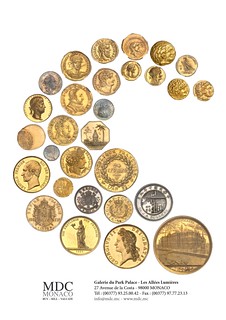 MDC Monnaies de Collections sarl introduces its next major numismatic auction by expert Nicolas Gimbert
in Monaco. Our experts have carefully selected 1446 rare coins and medals gathered in a beautifully illustrated
488 pages auction catalogue. Auction will take place over two days, live with Biddr Switzerland and on all
reference numismatic platforms. A sumptuous series of ancient Roman medallions of Magnentius, Maximian
Herculius, Maxentius, also the return in Europe of an extraordinary quality and extremely rare English coin
minted during the brief reign of Edward VIII, namely a 5-pound PROOF 1937 graded NGC PF 67 ULTRA
CAMEO (lot 1050). Amongst others: a fine series of 30 rare Vatican coins; an ancient collection of XVIIth and
XVIIIth century thalers in exceptional quality and often Fleur de coin.
MDC Monnaies de Collections sarl introduces its next major numismatic auction by expert Nicolas Gimbert
in Monaco. Our experts have carefully selected 1446 rare coins and medals gathered in a beautifully illustrated
488 pages auction catalogue. Auction will take place over two days, live with Biddr Switzerland and on all
reference numismatic platforms. A sumptuous series of ancient Roman medallions of Magnentius, Maximian
Herculius, Maxentius, also the return in Europe of an extraordinary quality and extremely rare English coin
minted during the brief reign of Edward VIII, namely a 5-pound PROOF 1937 graded NGC PF 67 ULTRA
CAMEO (lot 1050). Amongst others: a fine series of 30 rare Vatican coins; an ancient collection of XVIIth and
XVIIIth century thalers in exceptional quality and often Fleur de coin.
lot 135.
ROMAN EMPIRE Maximian Herculius (AD 286-305). 2 1/2 Aurei medallion, undated (294-305), Rome.
Obv. IMP C MA VAL MAXIMIANVS P AVG. Bust wearing the Nemean lion-skin facing right.
Rv. HERCVLI CONS - ERVATORI AVGG. Hercules seated on a rock, Nemean lion-skin on his lap, holding a club to his right with his left hand, bow and quiver to his left.
2 1/2 Aurei medallions are known under the tetrarchy; our unpublished and unlisted coin is in this series. The bust with Nemean lion-skin, inspired by the coinage of Commodus, clearly demonstrates the link between Maximian Herculius on the obverse and Hercules on the reverse. There are other examples.
lot 136.
ROMAN EMPIRE Maxentius (306-312). 4 Aurei medallion (quaternio), commemorating the Temple of
Venus and Rome restoration undated (c.308). Rome.
Obv. IMP C M VAL MAXENTIVS P F AVG. Bearded head left.
Rv. CONSERVA - TO - R VRBIS SVAE / PR. Helmeted Rome seated left with a shield adorned with the she- wolf suckling Romulus and Remus, holding a spear and a victoriola on a globe holding-out a crown.
lot 138. ROMAN EMPIRE Constantine I (307-337). 1 1/4 Solidus medaillon (festaureus) 335, Fifth workshop, Thessaloniki.
Av. CONSTANTI - NVS MAX AVG. Diademed head right.
Rv. VOTIS XXX in a wreath; in exergue (workshop).
Calicó 5200 - RIC.207 - Gnecchi 66 - Bastien, Donativa, 81g; Gold - 5.44 g - 25 mm - 12 h.
This gold medallion weighs 11/4 Solidus and corresponds to an Aureus according to the weight standard of the Diocletian reform. In Constantinian times, these multiples were issued for festive occasions by the Imperial Court, hence their Germanic name of festaureus. Our coin commemorates the 30th anniversary of the reign of Constantine I, which the emperor celebrated in July 335 with grand celebrations in Constantinopolis the new capital he named after himself.
lot 140. ROMAN EMPIRE Magnentius (350-353). 3 Solidi medallion, commemorating the liberation of the city of Aquileia, undated (c.351), Aquileia.
Obv. D N MAGNEN - TIVS P F AVG. Draped and cuirassed three-quarters bust right.
Rv. LIBERATOR REI PVBLICAE / SMAQ. Emperor in military attire on horseback. Right hand holding a scroll. Left hand holding a cornucopia.
The coin features the bust of Magnentius, depicted bare headed without attributes on the obverse, on the reverse as liberator of the state from the tyranny of Constantine I’s son. This commemorative depicts his entry into Aquileia at the end of year 350 or beginning of 351. Magnentius, Flavius Magnus Magnentius, was born circa 303 to parents with barbarian ancestry. He was rapidly promoted in the Roman army and became commander of Constans personal guard in 340. In 350, he led a successful revolt supported by his soldier, wearing the Emperor's purple mantle. Constans and Nepotianus were executed in Rome. Decentius was appointed Caesar to fight the Germans on the Rhine. In 351, Constantius II, Emperor of the Eastern Roman Empire, avenged these actions but was defeated and Magnentius seized Siscia. In September 351 at the deadly battle of Mursa, Magnentius fled to Lyon where he committed suicide in 353.
lot 242.
ARGENTINA Argentine Confederation (1831-1861). 8 Escudos 1832/1, RA, Rioja.
Obv. * PROVINCIAS DEL RIO DE LA PLATA. Radiant sun with face.
Rv. IN UNION Y LIBERTAD. RA. P. 8S. Coat-of-arms within wreath above crossed flags and cannon; drum below; below (date).
Date amended 1832 to 1831, unpublished variety. Normal wear on the high reliefs with original luster. Mint state.
lot 299. BELGIUM Leopold I (1831-1865). gold Specimen 100 Francs, Duke and Duchess of Brabant wedding, PROOF 1853, Brussels.
Obv. LEOPOLD PREMIER ROI DES BELGES. Bare head left, signature L. WIENER.
Rv. L. L. PH. M. V. DUC DE BRABANT M. H. A. DUCHESSE DE BRABANT / 21-22 AOUT 1853. Conjoined busts right, LEOP. WIENER signature.
Considered a gold 100 Francs specimen. The striking of a 37 mm specimen corresponds to a 5 francs coin.
lot 353. CHINA Republic of China (1912-1949). Xu Shichang dollar, plain edge, with attribution to Dr J. A. BUSSIÈRE, Year 10 (1921). Unique, of the greatest historical interest!
Av. Xu Shichang (Hsu Shih-Chang) Three-quarters bust.
Rv. Chinese characters text. Beijing Hospital pavilion entrance view.
Unique, with attribution on the reverse, to Doctor Jean Augustin Bussière (1872-1958), French military doctor. After his baccalaureate, Jean Augustin Bussière joined the Brest École de Médecine de la Marine in 1890, then the Bordeaux Ecole de Médecine de la Marine et des Colonies. He goes to Cherbourg in 1895 and soon after to Senegal where plague, cholera and other tropical diseases were rife. He then works in French India, Karical, Mahé and Pondicherry, where he manages the Medicine School and meets his wife, she is daughter of Lyon traders. In 1902 he reinforced the vaccination team at the Institut Pasteur in Saigon (Tonkin, Northern Vietnam) before being appointed in Persia. He then travels back to France and becomes deputy to the Director of the Colonial Health Service.
Admirer of Yersin's medical discoveries he chooses to go to Tianjin in China, 41 years old, he is then unaware he will be in China for the next 41 years. He becomes the medical advisor of the Chinese presidency and shares with Dr. Watt Wing the last days of Yuan Shikai in 1916. He then is doctor to presidents Li Yuanhong (1916-1917), Feng Guozhang (1917-1918), Xu Shichang (1918-1922) or Cao Kun (1923-1924). He becomes a major figure of the French presence in China and is appointed Alliance Française director and French Red Cross Beijing committee chairman. On his country estate northwest of Beijing, he grows a garden and looks after the needy in the countryside using the wealthier city citizens’ funds. During WWII, defying danger he helped the Chinese fight against the Japanese invaders and becomes a hero for China and is so described by President Xi-Jinping during his visit in France in 2014. In 1954, back in France, he returned to his native village by the Sioule river and passes away the age of 86.
lot 425. FRANCE Henri II (1547-1559). Gold Gallia demi-Henri d ´or, undated (1552), Paris.
Obv. HENRICVS. II. DEI. G. FRAN. REX. Laureate armored bust right.
Rv. OPTIMO PRINCIPI. Helmeted Gaul seated on the trophy of arms left holding a tiny Victory in her right hand, Victory holding out a crown; in exergue under the floor line: GALLIA.
lot 452. FRANCE Louis XIII (1610-1643). Gold Huit Louis d'or ‘tête laurée’ 1640, A, Paris.
Obv. LVD. XIII. D. G. FR. ET. NAV. REX. King’s laureate head left, below (date).
Rv. CHRISTVS. REGNAT. VINCIT. ET. IMPERAT. Crowned cruciform opposed Ls; lis in quarters. Milled edge.
For more information, see:
http://www.mdc.mc/
MDC MONACO JEAN LECOMPTE COLONIAL TOKENS
The MDC Monaco Auction 8 closing October 20-21, 2021 includes selections from the Jean Lecompte collection of French colonial numismatics. Here's that section of the sale press release. -Editor
AN OUTSTANDING COLONIAL TOKENS SERIES (161 LOT NUMBERS)
Jean Lecompte is the world-renowned specialist in French colonies numismatics and the author of the reference book on the subject (Monnaies et jetons des colonies française, Gadoury editions, 2007). French colonial empire numismatics is extremely rich and varied from all parts of the world and the five continents (America, Africa, Indochina, Oceania, and even Terre Adélie). The first part of his collection, the medals of the French colonies was sold in Paris, hôtel Drouot (expert: S. Sombart) in 2018. Today, it is a second part, with 161 lots presented in Monaco by experts: N. Gimbert and S. Sombart. Exceptional tokens, some unique or from prestigious collections such as that from King Farouk of Egypt, are on sale in this exceptional October 20 and 21 2021 auction. The Jean Lecompte collection is so significant a special catalog will be published separately from the auction.
lot 1361.
AMERICA-CANADA (French Colonies), Louis XV (1715-1774). Medal, commemorating a June 8, 1755
battle, the beginning of the Seven Years' War. By Peter Paul Werner 1755, Nuremberg.
Obv. SALVS IN FLVCTIBVS. On shore, Mercury standing face-on, his hand raised to his ear to listen, between two vessels seen from the rear, one with the Irish flag, the other with a French flag; in exergue: STATVS RERVM and P. P. W. signature.
Rv. SED MOTOS PRAESTAT COMPONERE FLVCTVS. By the ocean, a crowned allegory with a scepter, seated left on a sea-horse, a cornucopia at her feet, holding a temple, on the other side a Native American on the right, her foot on an alligator, holding a bow and arrow; in exergue: SVB EXITVM ANNI MDCCLV. Lec.97a = cet ex. - Frossard 52 - Betts 392 ; Silver - 14,54 g - 35 mm - 12 h.
PCGS MS 62. Top Pop: The finest graded! Provenance: Jean Lecompte collection. This coin illustrated in the Jean Lecompte book, Monnaies et jetons des colonies française (The French Colonies Coins and Tokens) Gadoury editions, 2007, pp. 164-169
Slight handling marks. Beautiful patina. Extremely fine to Fleur de coin. Starting price: 2 000 €
This medal [classified as a token by J. Lecompte] commemorates the June 8, 1755 battle in the Gulf of St. Lawrence: the event precluding the 1756 declaration of the Seven Years' War between France and Austria against England and Prussia. In 1754, following several clashes between French and British Colonial forces, the British government sent troops to occupy Fort Duquesne, near present-day Pittsburgh, [Pennsylvania]. France was alerted and sent eighteen ships under the command of the squadron-chiefs Dubois de La Motte with reinforcement troops. Three armed vessels, four frigates and eleven ships of the line serving as troop transporters set out for Quebec.
The English Royal Navy sent two fleets to intercept the French, led by vice-admiral Boscawen and Vice-Admiral Francis Holburne. After five hours of fighting, the French ships Alcide (64 guns) and the Lys (22 guns) lowered their flags. The Dauphin Royal (22 guns) escaped to Louisbourg. Most of the French convoy managed to escape the British fleet. This deliberate aggression was an act of war. The British attack caused panic in Paris where the stock market collapsed because of the threat to Colonial trade. English propaganda reported a victory, however inglorious, since most of the French convoy passed safely. On August 29, 1756, the attack on Saxony by the Prussian King Frederick II led to the Seven Years' War.
Jean Lecompte collection are lots n° 155-185, 337, 366-369, 523, 684-685, 785-787, 822-825, 832, 924-925, 1060-1066, 1070-1077, 1089-1099, 1207-1220, 1227-1228, 1230-1232, 1267-1276, 1323-1325, 1348-1350, 1352, 1361-1409.
For more information, see:
http://www.mdc.mc/
NUMISMATIC NUGGETS: SEPTEMBER 12, 2021
Here's a selection of interesting or unusual items I came across in the marketplace this week. Tell us what you think of some of these. -Editor
This is an original document, dated 1786, Pennsylvania Assembly, where Thomas Mifflin and John Nicholson have signed an order to Robert Loller to count and burn currency....signed by Thomas Mifflin and John Nicholson on front and by Robert Loller on back. Document is 4x8, minor splits, repairs with acid free archival tape, overall good condition. Thomas Mifflin (January 10, 1744 – January 20, 1800) was an American merchant, soldier, and politician from Philadelphia, Pennsylvania. He served in a variety of roles during and after the American Revolution, several of which qualify him to be counted among the Founding Fathers. He was the first Governor of Pennsylvania, serving from 1790 to 1799; he was also the last President of Pennsylvania, succeeding Benjamin Franklin and serving from 1788 until 1790.
Born in Philadelphia, Mifflin became a merchant after graduating from the College of Philadelphia. He joined the Continental Army after serving in the Pennsylvania Provincial Assembly and the Continental Congress. During the American Revolutionary War, he was an aide to General George Washington and the Continental Army's Quartermaster General, rising to the rank of major general. Mifflin returned to Congress in 1782 and was elected President of the Continental Congress in 1783. He served as Speaker of the Pennsylvania House of Representatives from 1785 to 1787, then as President of the Pennsylvania Supreme Executive Council from 1788 to 1790.
Mifflin was a delegate to the 1787 Philadelphia Convention and signed the United States Constitution. He then presided over the committee that wrote Pennsylvania's own constitution and he became the first governor after the ratification of the constitution. Mifflin left office as governor in 1799, and died the following year.
This auction has ended, but congratulations to the buyer. It's a very interesting document discussing the burning of colonial currency. Found via Ray Williams on the Colonial Coins Google discussion group. -Editor
To read the complete lot description, see:
1786, Thomas Mifflin signed order, burn Colonial currency, Robert Loller signed
(https://www.ebay.com/itm/353603128880)
1857 FLYING EAGLE CENT LOVE TOKEN "LIDEY" ON BOTH
Interesting script counterstamp, and Flying Eagle cents are seldom seen as an undertype. Or is this indeed engraved as a Love Token? I reached out to Carol Bastable of the Love Token Society. -Editor
Carol writes:
"It looks like it is counterstamped. Supporting diagnostics:
- Depth of line appears uniform with no bevels/angles in the lines.
- Parts of letters are missing, supporting a strike that did not have enough pressure in those areas."
"You could even go so far as to overlay the two names on top of one another and they will probably line up (except of course for the missing parts due to strike). Anything done by hand will have slight differences and will not ever match.
 "This would not be considered a love token.
By definition, a love token must be hand engraved and on a coin of the realm. This lacks half of the criteria since it is stamped.
"This would not be considered a love token.
By definition, a love token must be hand engraved and on a coin of the realm. This lacks half of the criteria since it is stamped.
"Also, I believe that L is really an S. Here is a chart of typical script lettering."
Carol may be on to something there - It does look like an S for Sidey. Thanks! This looked like a counterstsamped piece to me, too. -Editor
To read the complete lot description, see:
1857 FLYING EAGLE CENT LOVE TOKEN ''LIDEY" ON BOTH
(https://auctions.bidalotcoinauction.com/lots/view/1-4ZJS0E/1857-flying-eagle-cent-love-token-lidey-on-both)
Draper, Toppan, Longacre & Co. Banknote Specimen Engraving and Photograph of Another Specimen Sheet, an example used to show different elements to be printed on the then-current and now-obsolete bank note series. Estimate $200-250
From the Skinner auction house. Looks like this lot includes one actual specimen sheet plus a photograph of a different sheet. -Editor
To read the complete lot description, see:
Draper, Toppan, Longacre & Co. Banknote Specimen Engraving and Photograph of Another Specimen Sheet
(https://live.skinnerinc.com/lots/view/4-3KI2H4/draper-toppan-longacre-co-banknote-specimen-engraving-and-photograph-of-another-specimen-sheet)
Qing Dynasty, silver $1, Guangxu Yuan Bao, Central Mint, (LM-11)
A nice coin from the upcoming Spink Hong Kong sale. -Editor
To read the complete lot description, see:
QING DYNASTY, SILVER $1, GUANGXU YUAN BAO, CENTRAL MINT,
(https://live.spink.com/lots/view/4-3JHIR4/qing-dynasty-silver-1-guangxu-yuan-bao-central-mint-)
DENMARK GOLD FIND EXHIBITED
Robert Hoge passed along this story of a great Iron Age gold find. Thanks. -Editor
Ole Ginnerup Schytz’s first time using a metal detector proved a rewarding one last December when the rookie treasure hunter found a stunning cache of 6th century gold jewelry in a field near the town of Jelling in Denmark.
When the device’s sensors activated, Schytz started digging, unearthing a small piece of twisted metal. It was scratched and covered in mud,
he told the state television station TV Syd. I had no idea, so all I could think of was that it looked like the lid of a can of herring.
The reality was far more exciting: In an astounding bit of beginner’s luck, Schytz had stumbled across no fewer than 22 pieces of gold treasure from the Iron Age, weighing just over two pounds in total. It had been buried for some 1,500 years.
Now, eight months later, the stunning find, which predates the Viking era, has been revealed in all its glittering glory by the Vejlemuseerne in southern Jutland.
This is the biggest find that has come in the 40 years I have been at the National Museum. We have to go back to the 16th and 18th centuries to find something similar,
archaeologist Peter Vang Petersen, of Copenhagen’s National Museum of Denmark, told TV Syd.
The bulk of the treasure are bracteates, a kind of flat thin medallion with engravings on one side that was common in northern Europe during the Migration Period (375–568). The jewelry is decorated with runes, magical symbols, and religious imagery such as the Norse god Odin, all reflecting delicate craftsmanship of the highest order. Women would have worn the amulets for protection.
Other gold pieces are coins from the Roman Empire, including one from the reign of Constantine the Great, who was in power from 285–337, hundreds of years before the gold was buried in a village longhouse. That suggests a robust trade network across the European continent, while the treasure’s enormous wealth suggests the area around Jelling was a seat of power.
Experts believe the gold was hidden around the time of a large volcanic eruption in the year 536, which triggered widespread famine in Scandinavia.
To read the complete article, see:
See the Stunning Trove of Iron Age Gold Discovered by a Rookie Metal Detectorist Now on View in a Danish Museum
(https://news.artnet.com/art-world/metal-detector-discovery-ancient-gold-jewelry-denmark-2006074)
To read another article with more images, see:
‘Enormous’ treasure trove of sixth century gold found in Denmark
(https://www.euronews.com/2021/09/06/enormous-treasure-trove-of-sixth-century-gold-found-in-denmark)
GOLD COIN CACHE FOUND IN FRENCH MANSION
As noted before, not all coin finds require metal detectors. Howard Berlin and Leon Saryan passed along this story of a nice find in a house under renovation in France. Pablo Hoffman and David Gladfelter passed along a Smithsonian article on the find. Thanks. -Editor
Builders discovered a stash of 239 gold coins at a manor in northwestern France which could earn up to 300,000 euros ($356,490) at auction later this month.
The three craftsmen found the treasure while working on the restoration of a house in Plozévet, Brittany, in the coastal area of Bigouden in 2019, according to a press release from auctioneers Deloys ahead of the sale. The property had been purchased by a couple in 2012.
While merging a barn and a nursery, the builders found a metal box lodged inside a wall, which had gold coins inside. Just days later, above a beam, they spotted a purse containing another set of coins.
All 239 coins were minted during the sovereignty of Louis XIII and Louis XIV, according to the Regional Preventive Archaeology Service in France, which authenticated, analyzed and researched the coins.
 The oldest of them dates back to 1638, with the most recent from 1692.
The oldest of them dates back to 1638, with the most recent from 1692.
There are several especially rare coins among the collection, including the Golden Louis with Templar Cross, Golden Louis with a long curl, and Louis XIV by the Atelier de Dijon -- which has an estimated value of 15,000 euros ($17,805).
The mansion itself was constructed in the 13th century and would have been owned by a family of affluent merchants or farmers, with the identity of the last known occupants stemming from the 18th century.
To read the complete article, see:
Builders discover stash of 239 gold coins worth up to $356,000
(https://edition.cnn.com/style/article/brittany-builders-discover-gold-coins-intl-scli/index.html)
To read the Smithsonian article, see:
Trove of 239 Rare Gold Coins Discovered in Walls of French Mansion
(https://www.smithsonianmag.com/smart-news/trove-239-rare-gold-coins-discovered-walls-french-mansion-180978575/)
LOOSE CHANGE: SEPTEMBER 12, 2021
Here are some additional items in the media this week that may be of interest. -Editor
It's been said that the second coin in the world was a counterfeit of the first. Today, counterfeits can hit the streets BEFORE the genuine ones. Here's a report from Coin World. -Editor
Suspected counterfeit 2021-CC Morgan dollars were offered on eBay in August at the same price the U.S. Mint offered genuine examples on May 24.
The eBay offer was subsequently removed, but not before a collector downloaded images of the fake in its crude packaging and posted notice on the Collector’s Universe U.S. Coin Forum discussion group to warn hobbyists.
The Mint isn’t scheduled to begin shipping the genuine CC privy-marked 2021 Morgan dollars to customers who ordered them until sometime in October, based on production schedules.
To read the complete article, see:
(https://www.coinworld.com/news/us-coins/fake-2021-cc-dollars-found-before-release-of-genuine-coins)
Here's a story from Taiwan about a remorseful counterfeit-passer. -Editor
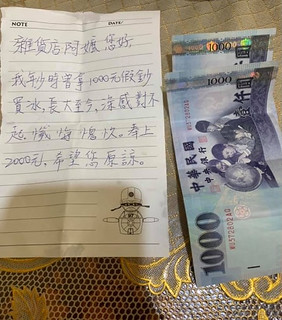 After supposedly using counterfeit money to buy ice cream when he was young, a Taiwanese man has since repented and returned the money to the "Ah Ma" that runs the shop, Taiwanese media ETtoday reported.
After supposedly using counterfeit money to buy ice cream when he was young, a Taiwanese man has since repented and returned the money to the "Ah Ma" that runs the shop, Taiwanese media ETtoday reported.
In a handwritten apology letter, the man wrote that since he used a counterfeit NTD1,000 (S$48) note to buy ice cream from the Ah Ma in his younger years, he felt guilty and apologetic all the time.
The man proceeded to return NTD2,000 (S$97) to the Ah Ma and hoped that he could gain her "forgiveness".
The incident was posted on Facebook by a man believed to be the Ah Ma's grandson, and has since gone viral with over 27,000 "likes" and 900 comments.
To read the complete article, see:
Man in Taiwan returns to apologise for buying ice cream with counterfeit money when he was young
(https://mothership.sg/2021/09/taiwanese-ice-cream-counterfeit-note/)
Floods in Germany damaged more than just buildings - a bank there is attempting to salvage waterlogged banknotes. -Editor
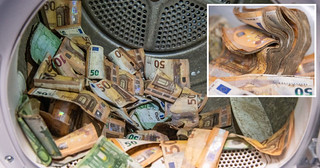 Victims of Germany’s severe summer flooding hope to get back more than €50 million in damaged currency.
Victims of Germany’s severe summer flooding hope to get back more than €50 million in damaged currency.
Flash floods in western regions claimed at least 183 lives and reduced thousands of homes to rubble in July.
Bundesbank officials are now working on a huge money laundering operation to clean and count notes that became soiled with mud, sewerage and oil.
The German central bank’s executive member Johannes Beermann said: ‘Processing the notes has to be done as quickly as possible before they solidify and become as hard as concrete.’
Submitted notes are washed, dried and examined to ensure they are genuine.
To read the complete article, see:
German bank literally launders €51,000,000 after notes damaged in flood
(https://metro.co.uk/2021/09/01/german-bank-literally-launders-51000000-after-notes-damaged-in-flood-15189269/)
THE BOOK BAZARRE
FEATURED WEB SITE: MINNESOTA NICE
This week's Featured Web Site is Shawn Hewitt's Minnesota Nice Antiques, with a great collection of information on Minnesota obsolete notes and National Currency. Found via News & Notes from the Society of Paper Money Collectors (Volume VII, Number 7, August 3, 2021).
Minnesota Nice Antiques is your ready resource for buying and selling rare paper money, postcards and collectibles from Minnesota and regional locations. Business founder Shawn Hewitt has a passion for history and items that are the props of history — bank notes, images and items of historical significance that tell stories about our past.
Shawn has been collecting paper money since age 10, and began his serious quest for hometown and home state treasures since 18. He now holds the finest collection of Minnesota Obsolete Bank Notes and Scrip ever formed, building on the work of legendary collectors in the hobby. In 2006, he and three colleagues published A History & Catalog of Minnesota Obsolete Bank Notes & Scrip, the standard reference in the field. He served the collectible paper money hobby as president of the Society of Paper Money Collectors national organization from 2017 to 2021.


